
www.catholicireland.net
Glossary of Roman Catholic Church terms, words and phrases’
Dear Visitor,
If you know of any other commonly used ‘Churchy’ terms, words or phrases that you would like us to add to this list, please send them to: editor@catholicireland.net
And we will try to include them as soon as we can.
Thank you.
Abbess – the legal head and spiritual mother of a monastery.
Abbot – the legal head and spiritual father of a monastery.
Acolyte – anyone who performs ceremonial duties such as lighting altar candles, or serving at Mass. The term is also used for one who has been inducted into a particular liturgical ministry, even when not performing those duties. This is no longer gender specific to males only.
Actual Grace – Spontaneous freely given act of divine love/mercy given to us because God desires us to have it because he sees we need it.

Ad Limina Visits — visit by diocesan bishops to the Holy See, usually every five years. The state of the Dioceses and the Church are discussed with the Holy Father.
Altar – a structure upon which offerings/sacrifices and worship are made for religious purposes. They are usually found at shrines, temples, churches, chapels, oratories and other places of worship. In the history of religious persecution they were also called Mass rocks.
Altar Server (C/f Acolyte above)
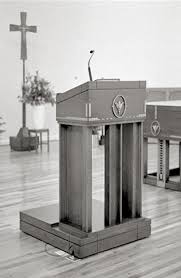
Ambo or Lectern – (from the Latin legere, “to read”), is a reading desk, with a slanted top, on which documents or books are placed as support for reading aloud, as in a scripture reading, lecture, or sermon.
Angelus Prayer – a Catholic devotion commemorating the Annunciation to Mary and the Incarnation of Jesus. As with many Catholic prayers, the name Angelus is derived from its incipit: Angelus Domini nuntiavit Mariæ (“… the Angel of the Lord declared unto Mary …”) and consists of 3 three Biblical verses narrating the mystery; alternating with the prayer “Hail Mary”. The devotion was traditionally recited in Roman Catholic churches, convents, and monasteries three times daily: 6:00 am, noon, and 6:00 pm (many churches still follow the devotion, and some practise it at home). The angel referred to in the prayer is Gabriel, a messenger of God who revealed to Mary that if she agreed she would conceive a child to be born the Son of God. (Luke 1:26–38). The devotion is also used by some Anglican and Lutheran churches. It is usually accompanied by the ringing of the Angelus bell, which is a call to prayer and to spread good-will to everyone. “In Ireland the daily ‘Angelus’ broadcast on RTÉ One is by far RTÉ’s longest-running Religious Programme. It is also, possibly, the most controversial. One proponent described Its appeal thus, “To the person of faith, it’s a moment of grace; to the person without faith, it’s a moment of peace. What’s not to like?” In the Easter season, (from Holy Saturday through Pentecost.) The Regina Coeli is sung or recited in place of the Angelus c/f Regina Coeli (below)The Text of the Prayer
V. The Angel of the Lord declared unto Mary.
R. And she conceived by the Holy Spirit.
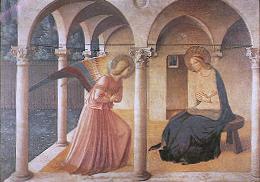 Hail, Mary, full of grace, the Lord is with thee. Blessed art thou among women, and blessed is the fruit of thy womb, Jesus. Holy Mary, Mother of God, pray for us sinners, now and at the hour of our death. Amen.
Hail, Mary, full of grace, the Lord is with thee. Blessed art thou among women, and blessed is the fruit of thy womb, Jesus. Holy Mary, Mother of God, pray for us sinners, now and at the hour of our death. Amen.
V. Behold the handmaid of the Lord.
R. Be it done unto me according to thy word.
Hail Mary……
V. And the Word was made flesh.
R. And dwelt among us.
Hail Mary……
V. Pray for us, O holy Mother of God.
R. That we may be made worthy of the promises of Christ.
Let us pray. Pour forth, we beseech Thee, O Lord, Thy grace into our hearts; that we, to whom the Incarnation of Christ, Thy Son, was made known by the message of an angel, may by His Passion and Cross be brought to the glory of His resurrection. Through the same Christ, our Lord. Amen.
Anointing of the sick – is a Sacramental ritual of healing appropriate not only for physical but also for mental and spiritual sickness. It is available to all seriously sick people.
Annulment – a Declaration of Nullity is ‘Judgement’ of a church court, confirmed by an appellate court, that an ‘apparent marriage’ was not valid from the start because something was lacking: full knowledge and consent by both parties, freedom from force or grave fear, or some other factor needed for a valid marriage. “Putative” (meaning apparent or seeming) is a key word in the entire process: It refers to a marriage in which at least one party acted in good faith, believing it was valid at the time it took place. Children from a putative marriage are considered legitimate even if the marriage is later ruled to be invalid. This has been a source of one of the major popular misunderstandings of annulments; namely, that an annulment somehow makes the children of that union illegitimate. Church law explicitly rejects this interpretation, saying that children of a putative marriage are legitimate even if the marriage is later judged to be invalid.
Apostolic administrator – a prelate appointed by the Pope to serve as the ordinary for an apostolic administration.
Apostolic Blessing – a blessing that follows the anointing of a person who may be close to death.It takes the form of a diologue with the dying person and those present and offers the consolation of God’s constant love for humanity. It begins with asking God’s peace on the household. It affirms the tradition of passing from life through death to the promise of a fuller life with God. The person involved draws strength and grace for their journey.c/f Anointing
Apostolic Chancery – a dicastery or department of the Roman Curia. The chief official was the Cardinal Chancellor of Holy Roman Church. In 1973 ts functions were transferred to the Secretariat of State in Rome.
Apostolic life, c/f Society of apostolic life (below)
Apostolic Nuncio to Ireland, Archbishop Jude Thaddeus Okolo is first African 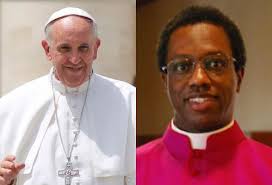 priest to hold church’s diplomatic role of apostolic Nuncio to Ireland. He formerly served as an apostolic nuncio to the Central African Republic and Chad in 2008, and then as the pope’s diplomatic representative to the Dominican Republic in 2013. Before becoming an apostolic nuncio, he had worked in the diplomatic service of the Holy See, where he was stationed in Sri Lanka, before going on to be a pontifical representative in Hati, Switzerland, the Czech Republic, Australia and the Antilles.The archbishop speaks English, French, Italian, Igbo, Spanish and German.
priest to hold church’s diplomatic role of apostolic Nuncio to Ireland. He formerly served as an apostolic nuncio to the Central African Republic and Chad in 2008, and then as the pope’s diplomatic representative to the Dominican Republic in 2013. Before becoming an apostolic nuncio, he had worked in the diplomatic service of the Holy See, where he was stationed in Sri Lanka, before going on to be a pontifical representative in Hati, Switzerland, the Czech Republic, Australia and the Antilles.The archbishop speaks English, French, Italian, Igbo, Spanish and German.
c/f Nuncio (below)
Apostolic prefect or prefect apostolic – is a priest who heads what is known as an apostolic prefecture, a missionary area where the Catholic Church is not yet sufficiently developed to have it made a diocese.The usual sequence of development is: mission, prefecture, vicariate, diocese.
Apostolic succession: Apostolic succession is the method whereby the ministry of the Christian Church is held to be derived from the apostles by a continuous succession.
Apostolic vicariate: a form of territorial jurisdiction of the Roman Catholic Church established in missionary regions and countries where a diocese has not yet been established.
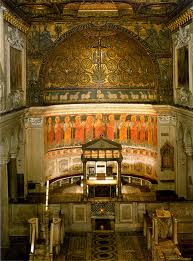 Apse – the apse (from Latin absis: “arch, vault” is a semicircular recess covered with a hemispherical vault or semi-dome which stands at the liturgical east end of the church (where the altar is), regardless of the shape of the roof, which may be flat, sloping, domed, or hemispherical.
Apse – the apse (from Latin absis: “arch, vault” is a semicircular recess covered with a hemispherical vault or semi-dome which stands at the liturgical east end of the church (where the altar is), regardless of the shape of the roof, which may be flat, sloping, domed, or hemispherical.
(The image is that of San Clemente Basilica, Rome. The dome is the classic symbol of Heaven as its shape imitates the dome of the sky. It is fitting as the Sanctuary is often thought of as a little piece of Heaven).
Archbishop — the bishop of an archdiocese, with limited jurisdiction over his suffragan sees; a titular and largely honorary designation granted to certain bishops, often Nuncios and other members of the Holy See diplomatic corps.
Archpriest (Latin Church) — see: Vicar Forane (below)
Ascension of Jesus (anglicized from the Vulgate Latin Acts 1:9-11 section title: Ascensio Iesu) is the Christian teaching found in the New Testament that the resurrected Jesus was taken up to Heaven in his resurrected body, in the presence of eleven of his apostles, occurring 40 days after the resurrection.
Auxiliary bishop – an additional bishop assigned to a diocese because of the size or complexity of said diocese.
Baptism – The first and basic Christian sacrament (C/f Sacrament below) of initiation or admission and adoption, almost invariably with the use of water, into the Christian Church generally. Jesus himself was reported baptised by John the Baptist in the Jordan river in the early chapters gospels of Matthew, Mark and Luke. Baptism is also called christening a word often reserved for the baptism of infants.
The usual form of baptism among the earliest Christians was for the candidate to be immersed, either totally (submerged completely under the water) or partially (standing or kneeling in water while water was poured on him or her). Other common forms of baptism now in use include pouring water three times on the forehead, a method called affusion.
Martyrdom was accepted early in Church history as “baptism by/of blood”, enabling martyrs who had not been baptized by water to be saved. It is commonly referred to as: baptism of desire.’
Baptism of Jesus – This marks the beginning of Jesus’ public ministry and is described in the gospels of Matthew, Mark and Luke. The Baptism of Jesus is one of the five major milestones in the gospel narrative of the life of Jesus, the others being the Transfiguration, Crucifixion, ,Resurrection and Ascension.
Baptismal Font – is an article of church furniture used in the administration of the sacrament of Baptism. The fonts are intended for baptisms using a non-immersion method, such as aspersion or affusion. They are often placed at or near the entrance to the main body of the church to remind believers of their baptism as they enter the church to worship, since the rite of baptism served as their initiation into the Church.
Beatification – (from Latin beatus, “blessed” and facere, “to make”) is a recognition accorded by the Catholic Church of a dead person’s entrance into Heaven and capacity to intercede on behalf of individuals who pray in his or her name. ‘Blesseds’ are celebrated regionally not universally. It is the second stage of a three part eccesiastical process. Stage one is to pronounce a deceased holy person, ‘venerable’. Stage two is to announce them ‘blessed’. The third, final stage is canonisation after which we call them ‘saint’. In the early church this was often done by acclamation of the faithful.
 Bible – also referred to as The Good Book, The Holy Book, Scriptures, Holy Writ, and The Word of God. The name bible comes from the Koine Greek τὰ βιβλία, tà biblía, a collection of texts sacred to Judaism and Christianity, written at different times by different authors in different locations. The basic division of the 73 book Bible is into the Old and New Testaments. The Christian Old Testament overlaps with the Hebrew Bible and the Greek Septuagint. The New Testament is a collection of writings by early Christians, consisting of narratives, (Gospels and Acts) letters, (e.g. Ss Peter and Paul, and some apocalyptic writings (e.g. St John). Jews and Christians consider the books of the Bible to be a product of divine inspiration or an authoritative record of the relationship between God and His people.
Bible – also referred to as The Good Book, The Holy Book, Scriptures, Holy Writ, and The Word of God. The name bible comes from the Koine Greek τὰ βιβλία, tà biblía, a collection of texts sacred to Judaism and Christianity, written at different times by different authors in different locations. The basic division of the 73 book Bible is into the Old and New Testaments. The Christian Old Testament overlaps with the Hebrew Bible and the Greek Septuagint. The New Testament is a collection of writings by early Christians, consisting of narratives, (Gospels and Acts) letters, (e.g. Ss Peter and Paul, and some apocalyptic writings (e.g. St John). Jews and Christians consider the books of the Bible to be a product of divine inspiration or an authoritative record of the relationship between God and His people.
With estimated total sales of over 5 billion copies, the Bible is widely considered to be the best-selling book of all time. It has estimated annual sales of 100 million copies, and has been a major influence on literature and history, especially in the western World.
Bible, Catholic –a Bible published in accordance with the prescriptions of Catholic canon law, which states: Books of the sacred scriptures cannot be published unless the Apostolic See or the conference of bishops has approved them. For the publication of their translations into the vernacular, it is also required that they be approved by the same authority and provided with necessary and sufficient annotations.The Catholic Bible is composed of the 46 books of the Old Testament and the 27 books of the New Testament.
The Old Testament consists of:
Genesis, Exodus, Leviticus, Numbers, Deuteronomy
Joshua, Judges, Ruth, 1 Samuel, 2 Samuel, 1 Kings, 2 Kings, 1 Chronicles, 2 Chronicles, Ezra, Nehemiah, Tobit, Judith, Esther, Job,
Psalms, Proverbs, Ecclesiastes, Song of Solomon, Wisdom, Sirach
Isaiah, Jeremiah, Lamentations, Baruch, Ezekiel, Daniel, Hosea, Joel, Amos, Obadiah, Jonah, Micah, Nahum, Habakkuk, Zephaniah, Haggai, Zechariah, Malachi, 1 Maccabees, 2 Maccabees,
The New Testament consists of
The Gospels : Matthew, Mark, Luke, John,
Acts and Pauline Epistles : Romans, 1 Corinthians, 2 Corinthians, Galatians, Ephesians, Philippians, Colossians, 1 Thessalonians, 2 Thessalonians, 1 Timothy, 2 Timothy, Titus, Philemon, Hebrews
General Epistles : James, 1 Peter, 2 Peter, 1 John, 2 John, 3 John, Jude, Revelation.
Biblical Translations, (Versions) – are the most literal translations such as the King James Version (KJV), the New King James Version (NKJV), the New American Standard (NAS), and the Douay-Rheims Versions. Slightly less literal translations, such as the Revised Standard Version (RSV), and the Confraternity Version.
Then there are mostly dynamic translations such as the New International Version (NIV) and the New American Bible (NAB).
And toward the dynamic end of the spectrum are translations such as the New Jerusalem Bible (NJB) (This is the english version approved for use in Liturgy for Ireland, England etc). The New English Bible (NEB), the Revised English Bible (REB), the Contemporary English Version (CEV), and the “Good News Bible,” whose translation is called ‘Today’s English Version (TEV)’.
One translation that is hard to place on the spectrum is the New Revised Standard Version (NRSV). The basic text of the NRSV is rendered literally, following the RSV, but it uses “gender inclusive language,” which tries to translate the original text into a modern “gender neutral” cultural equivalent. When you read the NRSV you will often encounter “friends,” “beloved,” and “brothers and sisters,” and then see a footnote stating “Gk brothers.” The NRSV also shows a preference for using “God” and “Christ” when the original text says “he.”
Bishop – an ordained minister who holds the fullness of the sacrament of Holy Orders and is responsible for teaching the Catholic faith and ruling the Church in his assigned jurisdiction. Catholics trace the origins of the office of bishop to the apostles, who it is believed were endowed with a special charism by the Holy Spirit at Pentecost. We believe this special charism has been transmitted through an unbroken succession from the Apostles by the laying-on of hands in the sacrament of Holy Orders.[
Bishop Emeritus – (or Archbishop emeritus or Pope emeritus) — an honorary title given to a retired bishop, archbishop or pope.
Broadcast Mass on Internet/T.V. – c/f Mass on Internet/TV. below
Brother— a lay member of a Catholic religious institute in which they promise public vows and lead a life in common.
 Canon Law – is the system of laws and legal principles made and enforced by the hierarchal auutorities of the Church to regulate its external organization and government and to order and direct the activities of Catholics toward the mission of the Church. It was the first modern Western legal system and is the oldest continuously functioning legal system in the western world.
Canon Law – is the system of laws and legal principles made and enforced by the hierarchal auutorities of the Church to regulate its external organization and government and to order and direct the activities of Catholics toward the mission of the Church. It was the first modern Western legal system and is the oldest continuously functioning legal system in the western world.
It has all the ordinary elements of a mature legal systems,laws, courts, lawyers, judges, a fully articulated legal code, principles of legal intrepretation and coercive penalties. However it lacks civilly-binding force in most secular jurisdictions. c/f below: Code of Canon Law 1917 and 1983
Cardinal – a senior ecclesiastical leader, an ecclesiastical prince, and usually (now always for those created when still within the voting age-range) an ordained bishop of the Church. The cardinals of the Church are collectively known as the College of Cardinals. A cardinal’s primary duty is electing the pope when the post becomes vacant. During the ‘sede vacante’ (the period between a pope’s death or resignation and the election of his successor), the day-to-day governance of the Holy See is in the hands of the College of Cardinals. c/f College of Cardinals below
Cardinal Vicar – a title commonly given to the vicar general of the Diocese of Rome for the portion of the diocese within Italy. The official title, is “Vicar General of His Holiness”. The Pope is officially and fundamentally the Bishop of Rome and as such appoints the Cardinal Vicar with ordinary power to help with the spiritual administration of his diocese.
Catholic Hymns – Hymns approved for use in the Catholic Church especially for liturgical purposes or Hymns expressing Catholic Theology
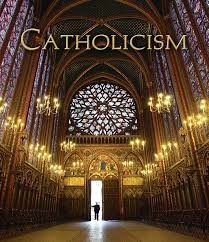 Catholicism – (from Greek καθολικισμός, katholikismos, “universal doctrine”) and its adjectival form Catholic are used as broad terms for describing specific traditions in the Christian churches in theology, doctrine, liturgy, ethics, and spirituality.
Catholicism – (from Greek καθολικισμός, katholikismos, “universal doctrine”) and its adjectival form Catholic are used as broad terms for describing specific traditions in the Christian churches in theology, doctrine, liturgy, ethics, and spirituality.
The Catholic Church, also known as the Roman Catholic Church, is the largest Christian church, with more than 1.25 billion members worldwide. One of the oldest religious institutions in the world, it has played a prominent role in the history of Western civilisation.Headed by the Bishop of Rome, known as the Pope,(at present, Pope Francis 1). Its doctrines are summarised in the Nicene Creed. It is notable within Western Christianity for its celebration of the seven sacraments.
There are several such ‘sui iuris’ particular churches within the Catholic Church. Examples are the Maronite Church, the Ukrainian Greek Catholic Church, and the Syro-Malabar Catholic Church. They differ from each other in liturgy (ceremonies, vestments, chants, language), devotional traditions, theology, canon law, and pastors (even if in the same territory as another), but they all hold the same faith, and all see union with the bishop of Rome, the pope, as essential to being a Catholic.
The Eastern Catholic Churches, also historically known as ‘Uniate’ Churches, are 23 self-governing particular churches in full communion with the Pope. Together with the Latin Church, also known as the Western Church, they make up the Catholic Church. Liturgies of the 23 Eastern Catholic churches include the Byzantine, Alexandrian, Armenian, East Syrian, and West Syrian Rites.
The Catholic Church teaches that it is the one true church founded by Jesus Christ, that its bishops are the successors of Christ’s apostles, and that the Pope is the successor to Saint Peter. It carries the 4 marks of the true church as listed in the Nicene Creed, One, Holy, Catholic (universal) and Apostolic. (c/f Christianity below)
Catholic Bible – c/f Bible, Catholic
 Catholic Charismatic Renewal – a spiritual movement within the Catholic Church that incorporates aspects of both Catholic and charismatic practice. It places an emphasis on having a personal relationship with Jesus and expressing the gifts of the Spirit. Parishes that practice charismatic worship usually hold prayer meetings outside of Mass and feature such gifts as prophecy, faith healing, and glossolalia (speaking in tongues). Charismatic worship is sometimes described as praying with uplifted hands during spoken prayers and songs and audible praying in tongues. They go on to say that what distinguishes a charismatic Catholic church from a traditional one is their surrender to Jesus in all parts of life, obedience to both the Gospel and the Catholic teachings, and friendships centred on Jesus.
Catholic Charismatic Renewal – a spiritual movement within the Catholic Church that incorporates aspects of both Catholic and charismatic practice. It places an emphasis on having a personal relationship with Jesus and expressing the gifts of the Spirit. Parishes that practice charismatic worship usually hold prayer meetings outside of Mass and feature such gifts as prophecy, faith healing, and glossolalia (speaking in tongues). Charismatic worship is sometimes described as praying with uplifted hands during spoken prayers and songs and audible praying in tongues. They go on to say that what distinguishes a charismatic Catholic church from a traditional one is their surrender to Jesus in all parts of life, obedience to both the Gospel and the Catholic teachings, and friendships centred on Jesus.
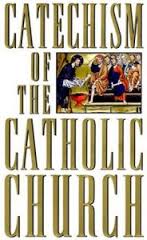
Catechism of the Catholic Church – an official catechism promulgated for the Catholic Church summing up the beliefs of the Catholic faithful.
Charity – the theological virtue by which we love God above all things for his own sake, and our neighbor as ourselves for the love of God. St Paul held it as “the greatest of the virtues.” c/f 1 Cor 13.
Chaplain of His Holiness – a priest to whom the Pope has granted this title. They are addressed as Monsignor.
Chalice – (from Latin calix, mug, borrowed from Greek kalyx, shell, husk) is a goblet or footed cup intended to hold a drink. In general religious terms, it is intended for drinking during a religious ceremony. In the Catholic Church it is a standing cup used to hold sacramental wine during the Eucharist (also called the Lord’s Supper or Holy Communion). Chalices are often made of precious metal, and they are sometimes richly enamelled and jewelled.
Chaplet – C/f Rosary (Below)
Charismatic Renewal c/f Catholic Charismatic Movement (above)
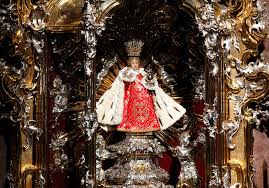
Original Child of Prague statue
Child of Prague – a 16th-century Roman Catholic wax-coated wooden statue of child Jesus holding a ‘globus cruciger’, located in the Discalced Carmelite Church of Our Lady Victorious in Malá Strana, Prague, Czech Republic.The globus cruciger (Latin, “cross-bearing orb”), an orb topped by a cross (Latin, crux), has been a Christian symbol of authority since the Middle Ages. The cross represents Christ’s dominion over the orb of the world, and held in the hand of an earthly ruler. In the iconography of Western art, when Christ himself holds the globe, he is called Salvator Mundi, the Saviour of the World. The minature Infant Jesus of Prague statue is a domestic adaptation of this tradition.
Many other traditions have developed around the domestic statue version. E.g. A small well- worn version of the statue is placed outside to plead for ‘good’ (suitable for my needs) weather on a particular day – please note, this is a tradition not a matter of faith!)
Child Protection Policy – the Irish church child protection policy or the Catholic Church in Ireland: ‘Our Children, Our Church’, is published by the Irish Episcopal Conference, the Conference of Religious of Ireland and the Irish Missionary Union.
It can be viewed online on the Irish Catholic Bishop’s conference website c/f www.safeguarding.ie and all religious orders’ websites or in all public church buildings that include services with/for children. c/f safeguarding( below)
 Christianity – an Abrahamic monotheistic religion based on the life and teachings of Jesus Christ as presented in the New Testament. Christianity is the world’s largest religion, with over 2.4 billion adherents, known as Christians. Christians believe that Jesus is the Son of God and the saviour of humanity whose coming as Christ or the Messiah was prophesied in the Old Testament. The name Christians was first given to the followers of Jesus in Antioch in St Paul’s time.
Christianity – an Abrahamic monotheistic religion based on the life and teachings of Jesus Christ as presented in the New Testament. Christianity is the world’s largest religion, with over 2.4 billion adherents, known as Christians. Christians believe that Jesus is the Son of God and the saviour of humanity whose coming as Christ or the Messiah was prophesied in the Old Testament. The name Christians was first given to the followers of Jesus in Antioch in St Paul’s time.
Christian theology is expressed in ecumenical creeds. These professions of faith state that Jesus suffered, died, was buried, and was resurrected from the dead, in order to grant eternal life to those who believe in him and trust in him for the remission of their sins. The creeds further maintain that Jesus bodily ascended into heaven, where he reigns with God the Father, and that he will return to judge the living and dead and grant eternal life to his followers. His ministry, crucifixion and resurrection are often referred to as “the gospel”, meaning “good news”. The term gospel (Good News) also refers to written accounts of Jesus’s life and teaching, four of which by Ss Matthew, Mark, Luke, and John.
Christian Community, Movement for Renewal, Ireland – brings together individuals in its communities who seek to become Christians in a form appropriate for our time. In the center of religious life in The Christian Community is the new service of worship, the Act of Consecration of Man. The Christian Community represents a worldview that sees the Deed of Christ as the decisive and most important event in human history. It is one of the most recent and fastest going religious groups in Ireland.
Clergy – Regular – see: Regular clergy (below)
Clergy – Secular – see: Secular clergy (below)
Coadjutor bishop — an auxiliary bishop with the legal right of succession to the see of which he is coadjutor
Code of Canon Law 1917 – or CIC from its latin name ((Codex Iuris Canonici) The 1917 Code is also referred to as the Pio-Benedictine Code and was the first official comprehensive codification of Latin canon law. It was promulgated on 27 May 1917 and took legal effect on 19 May 1918. It was in force until the 1983 Code of Canon Law took legal effect and abrogated it on 27 November 1983. It has been described as “the greatest revolution in canon law since the time of Gratian” (1150s AD). c/f Canon Law (above)
Code of Canon Law 1983 – is the “fundamental body of ecclesiastical laws for the Latin Church”. It is the second and current comprehensive codification of canonical legislation for the Latin Church sui juris of the Catholic Church. It was promulgated on 25 January 1983 by John Paul II and took legal effect on the First Sunday of Advent (27 November) 1983. It replaced the 1917 Code of Canon Law, promulgated by Benedict XV on 27 May 1917. c/f Canon Law (above)
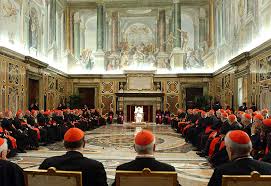 College of Cardinals- is the body of all cardinals of the Catholic Church. A function of the college is to advise the pope about church matters when he summons them to an ordinary consistory or council. It convenes on the death or resignation of a pope as a papal conclave to elect a successor but is then restricted to eligible Cardinals under the age limit, which was set for the first time in 1970 by Pope Paul VI at 80.The college has no ruling power except during the ‘sede vacante’ (papal vacancy) period. Historically, cardinals were the clergy serving parishes of the city of Rome under its bishop, the Pope.
College of Cardinals- is the body of all cardinals of the Catholic Church. A function of the college is to advise the pope about church matters when he summons them to an ordinary consistory or council. It convenes on the death or resignation of a pope as a papal conclave to elect a successor but is then restricted to eligible Cardinals under the age limit, which was set for the first time in 1970 by Pope Paul VI at 80.The college has no ruling power except during the ‘sede vacante’ (papal vacancy) period. Historically, cardinals were the clergy serving parishes of the city of Rome under its bishop, the Pope.
College of Consultors – a person who gives counsel, i.e., a counselor.
*in the Roman Curia, a consultor is a specially appointed expert who may be called upon for advice desired by a department. Consultors, who can be members of the clergy, female or male religious, or laity, and possibly even non-Catholics, are called upon according to need and according to their competence in specific fields. The decisions are then made by the cardinals and bishops who are members of the department involved.
*in a diocese, the college of consultors consists of priests charged with advising the bishop; some decisions require that they be given a hearing, others require their consent.
*in certain regular congregations (i.e. religious orders) consultors can advise the superior-general.
Communion – comes from the latin communio at one or in one. It is often used, in catholic circles, to indicate the consecrated species of bread and wine consecrated into the Body and Blood of the Lord. ( c/f: below for full communion, Mass , Eucharist and in communion). In other Christian denominations it often refers to a service of Divine worship.
Communion Rite –or Communion Service consists of the priest/deacon introducing the communal recitation or singing of the “Lord’s Prayer” (“Pater noster” or “Our Father”). He follows this up with a prayer and the people respond with the doxology. The sign of peace is exchanged and then the “Lamb of God” (“Agnus Dei” in Latin),
The priest/deacon then presents the previously consecrated bread to the congregation, saying: “Behold the Lamb of God, behold him who takes away the sins of the world. Blessed are those called to the supper of the Lamb.” Then all repeat: “Lord, I am not worthy that you should enter under my roof, but only say the word and my soul shall be healed.” Communion is distributed to the people. After some time for silent prayer, A formal prayer after Communion is then said, hymn sung, and the congregation is dismissed.
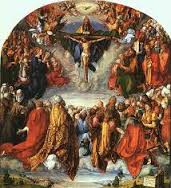 Communion of Saints – refers to the doctrine of the communion of saints is based on 1 Cor. 12 and refer to Christians, who, whatever their personal sanctity as individuals, are called holy because they are consecrated to God and Christ. It refers to all persons, living and the dead, those on earth, in heaven, and, for those who are in that state of purification. They are all part of a single “mystical body”, with Christ as the head, in which each member contributes to the good of all and shares in the welfare of all.
Communion of Saints – refers to the doctrine of the communion of saints is based on 1 Cor. 12 and refer to Christians, who, whatever their personal sanctity as individuals, are called holy because they are consecrated to God and Christ. It refers to all persons, living and the dead, those on earth, in heaven, and, for those who are in that state of purification. They are all part of a single “mystical body”, with Christ as the head, in which each member contributes to the good of all and shares in the welfare of all.
Confession – see: Sacrament of Penance (below) Reconciliation (below)
 Confirmation is seen as a sacrament that seals the covenant created in Baptism. It renders the bond with the Church more perfect” because, while a baptized person is already a member, reception of the sacrament of Confirmation is necessary for the completion of baptismal grace”. In the Eastern churches it is conferred immediately after baptism. In the Western churches this practice is followed when adults are baptized, but in the case of infants not in danger of death it is administered, ordinarily by a bishop, only when the child reaches the age of reason or early adolescence. Among those Catholics who practice teen-aged confirmation, the practice may be perceived, secondarily, as a “coming of age” rite.
Confirmation is seen as a sacrament that seals the covenant created in Baptism. It renders the bond with the Church more perfect” because, while a baptized person is already a member, reception of the sacrament of Confirmation is necessary for the completion of baptismal grace”. In the Eastern churches it is conferred immediately after baptism. In the Western churches this practice is followed when adults are baptized, but in the case of infants not in danger of death it is administered, ordinarily by a bishop, only when the child reaches the age of reason or early adolescence. Among those Catholics who practice teen-aged confirmation, the practice may be perceived, secondarily, as a “coming of age” rite.
Congregation – is used in four distinct senses, to mean a type of department in the Roman Curia, a type of religious institute, or some groups of Augustinian, Benedictine, and Cistercian houses, and a gathering of the faithful in church.
In the Roman Curia it refers to the highest-ranking departments of the Roman Curia. Lower-ranking departments include pontifical councils, pontifical commissions, tribunals, and offices.
The 1917 Code of Canon Law the name “religious order” is reserved for institutes in which the vows were solemn, and used the term “religious congregation” or simply “congregation” for those with simple vows. The current Code of Canon Law, which came into force in 1983, maintains the distinction between solemn and simple vows, but no longer makes any distinction between their juridical effects, including the distinction between “orders” and “congregations”. It has accordingly dropped the language of the 1917 code and uses the single term “religious institute to designate all such institutes of consecrated life alike.
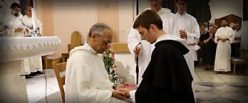 Consecrated life – is a stable form of Christian living by those faithful who feel called to follow Jesus Christ in a more exacting way recognised by the Church. It is characterised by the public profession of the evangelical counsels of poverty, chastity, and obedience, in a stable state of life recognised by the Church. Consecrated life may be lived either in institutes or individually. While those living it are either clergy (if ordained) or lay people, the state of consecrated life is neither clerical nor lay by nature.
Consecrated life – is a stable form of Christian living by those faithful who feel called to follow Jesus Christ in a more exacting way recognised by the Church. It is characterised by the public profession of the evangelical counsels of poverty, chastity, and obedience, in a stable state of life recognised by the Church. Consecrated life may be lived either in institutes or individually. While those living it are either clergy (if ordained) or lay people, the state of consecrated life is neither clerical nor lay by nature.
Ciborium (plural ciboria; Latin from the Ancient Greek κιβώριον (kibōrion) is a container or vessel, a normally metal.large covered cup designed to hold hosts for, and after, the Eucharist, thus the equivalent for the bread of the chalice for the wine.
Council, Pontifical – see: Pontifical Council (below)
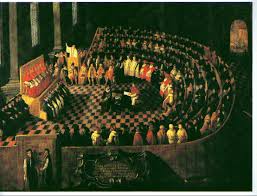
Counter-Reformation – Catholic Reformation, Catholic Revival – the period of Catholic revival beginning with the Council of Trent and ending at the close of the Thirty Years’ War(1648) initiated in response to the Protestant Reformation.
The Protestant Reformation, often referred to simply as ‘the Reformation’ (from Latin reformatio, lit. “restoration, renewal”). This was a schism from the Roman Catholic Church initiated by Martin Luther and continued by John Calvin and other early Protestant Reformers in 16th century Europe. c/f below)
Credence table is a small side table in the sanctuary of a church which is used in the celebration of the Eucharist. (Latin credens, -entis, believer).
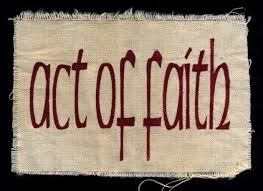 Creed –a brief summary of the teachings of the faith. The most ancient is the Apostles Creed below and the Nicene Creed developed as the faith evolved.
Creed –a brief summary of the teachings of the faith. The most ancient is the Apostles Creed below and the Nicene Creed developed as the faith evolved.
*The Apostles Creed – sets forth their doctrine “in sublime simplicity, in unsurpassable brevity, in beautiful order, and with liturgical solemnity.” In its present form it is dated no later than the fourth century. More than any other Christian creed, it may justly be called an ecumenical symbol of faith. It reads
I believe in God, the Father almighty, creator of heaven and earth.
I believe in Jesus Christ, his only Son, our Lord, who was conceived by the Holy Spirit and born of the virgin Mary.
He suffered under Pontius Pilate, was crucified, died, and was buried; he descended to hell.
The third day he rose again from the dead. He ascended to heaven and is seated at the right hand of God the Father almighty.
From there he will come to judge the living and the dead.
I believe in the Holy Spirit, the holy catholic church, the communion of saints, the forgiveness of sins, the resurrection of the body, and the life everlasting. Amen.
The Nicene Creed is a profession of faith widely used in Christian liturgy. It is called Nicene because it was originally adopted in the city of Nicaea (present day Iznik, Turkey) by the First Council of Nicaea in 325. The text can be found in the liturgy of the Word at Mass. It reads:
I believe in one God, the Father almighty, maker of heaven and earth, of all things visible and invisible.
I believe in one Lord Jesus Christ, the Only Begotten Son of God, born of the Father before all ages. God from God, Light from Light, true God from true God, begotten, not made, consubstantial with the Father; through him all things were made. For us men and for our salvation he came down from heaven, At the words that follow up to and including and became man, all bow. and by the Holy Spirit was incarnate of the Virgin Mary, and became man. For our sake he was crucified under Pontius Pilate, he suffered death and was buried, and rose again on the third day in accordance with the Scriptures. He ascended into heaven and is seated at the right hand of the Father. He will come again in glory to judge the living and the dead and his kingdom will have no end.
I believe in the Holy Spirit, the Lord, the giver of life, who proceeds from the Father and the Son, who with the Father and the Son is adored and glorified, who has spoken through the prophets.
I believe in one, holy, catholic and apostolic Church. I confess one Baptism for the forgiveness of sins and I look forward to the resurrection of the dead and the life of the world to come. Amen.
 Crosier (also known as a crozier, paterissa, pastoral staff, or bishop’s staff) is a stylized staff carried by high-ranking Roman Catholic, Eastern Orthodox, Anglican, and some Lutheran, United Methodist and Pentecostal prelates. Other typical insignia of many of these prelates are the mitre, the pectoral cross, and the episcopal ring. The crosier (known as the pastoral staff, from the Latin pastor, shepherd) is shaped like a shepherd’s crook. A bishop or church head bears this staff as “shepherd of the flock of God”, particularly the community under his canonical jurisdiction, but any bishop, whether or not assigned to a functional diocese, may also use a crosier when conferring sacraments and presiding at liturgies. A bishop usually holds his crosier with his left hand, leaving his right hand free to bestow blessings.
Crosier (also known as a crozier, paterissa, pastoral staff, or bishop’s staff) is a stylized staff carried by high-ranking Roman Catholic, Eastern Orthodox, Anglican, and some Lutheran, United Methodist and Pentecostal prelates. Other typical insignia of many of these prelates are the mitre, the pectoral cross, and the episcopal ring. The crosier (known as the pastoral staff, from the Latin pastor, shepherd) is shaped like a shepherd’s crook. A bishop or church head bears this staff as “shepherd of the flock of God”, particularly the community under his canonical jurisdiction, but any bishop, whether or not assigned to a functional diocese, may also use a crosier when conferring sacraments and presiding at liturgies. A bishop usually holds his crosier with his left hand, leaving his right hand free to bestow blessings.
 Crucifix (from the Latin cruci fixus meaning one fixed to a cross. The crucifix is a principal symbol for many Christian groups. It is an image of Jesus on the cross, as distinct from a simple bare cross. The representation of Jesus himself on the cross is referred to as the corpus (Latin for “body”). Large crucifixes high across the central axis of a church are known by the Old English term rood.
Crucifix (from the Latin cruci fixus meaning one fixed to a cross. The crucifix is a principal symbol for many Christian groups. It is an image of Jesus on the cross, as distinct from a simple bare cross. The representation of Jesus himself on the cross is referred to as the corpus (Latin for “body”). Large crucifixes high across the central axis of a church are known by the Old English term rood.
Curia consists of a group of officials who assist in the governance of a particular Church. These curias range from the relatively simple diocesan curia, to the larger patriarchal curias, to the Roman Curia, which is the central government of the Catholic Church.
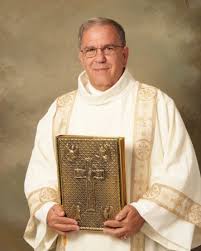 Deaconate/diaconate – Greek word diákonos (διάκονος), which is a standard ancient Greek word meaning “servant”, “waiting-man”, “minister”, or “messenger”. It is a ministry in the Christian Church that is generally associated with church service of some kind, but which varies among theological and denominational traditions. In many traditions the “deaconate”refers to the term for a deacon’s office. It is a clerical office to which to which one is ordained like priests and bishops.
Deaconate/diaconate – Greek word diákonos (διάκονος), which is a standard ancient Greek word meaning “servant”, “waiting-man”, “minister”, or “messenger”. It is a ministry in the Christian Church that is generally associated with church service of some kind, but which varies among theological and denominational traditions. In many traditions the “deaconate”refers to the term for a deacon’s office. It is a clerical office to which to which one is ordained like priests and bishops.
The Catholic Church has only male Deacons, who are ordained as a sacramental sign to the Church and to the world of Christ, who came to serve and not to be served. All ordained ministers in the Church are called to functions of Word, Sacrament, and Charity, but bishops, presbyters and deacons exercise these functions in various ways.
As ministers of Word, deacons proclaim the Gospel, preach, and teach in the name of the Church. As ministers of Sacrament, deacons baptize, lead the faithful in prayer, witness marriages, and conduct Eucharistic services and funeral services. They are not ordained to say Mass. As ministers of Charity, deacons assist in identifying the needs of others and marshalling the Church’s resources to meet those needs. But no matter what specific functions a deacon performs, they flow from his sacramental identity. In other words, it is not only what a deacon does, but who a deacon is, that is important.
A ‘lay’ deacon, so called by some people, is a person who may have no intention or desire to become a priest, or take on the promise o celibacy, thus may or may not marry or work full time with the church.
Death, Christian – the end of a Christian person’s earthly life and the beginning of the eternal life in heaven, in the presence of God. According to our Christian faith, each person possesses a soul that leaves their body at the point of death and goes to an afterlife in heaven or hell. Catholics. We believe that we all will be called to judgement by God for our actions and as a consequence of our actions and God’s mercy we will be rewarded with a place in heaven, punished in hell or purified in purgatory.
Dean — c/f Vicar forane (below)
Declaration of Nullity — a canonical judicial declaration that a marriage or matrimonial covenant was invalid from the beginning due to some point of law or actions by the parties involed.
 Devil – (from Greek: διάβολος or diábolos slanderer or accuser is, according to Christianity and Islam, the primary opponent of God. Traditonally Christianity identifies the Devil (“Satan”) with the Serpent who tempted Adam and Eve to eat the forbidden fruit, and describes him as a “fallen angel” who terrorizes the world through evil, is the antithesis of Truth. In the New Testament, the name Satan occurs more than 30 times in passages alongside diábolos, referring to the same person or thing as Satan. Islam identifies the Devil (“Shaitan”) with all those who oppose Allah.
Devil – (from Greek: διάβολος or diábolos slanderer or accuser is, according to Christianity and Islam, the primary opponent of God. Traditonally Christianity identifies the Devil (“Satan”) with the Serpent who tempted Adam and Eve to eat the forbidden fruit, and describes him as a “fallen angel” who terrorizes the world through evil, is the antithesis of Truth. In the New Testament, the name Satan occurs more than 30 times in passages alongside diábolos, referring to the same person or thing as Satan. Islam identifies the Devil (“Shaitan”) with all those who oppose Allah.
The Modern English word devil descends from the Middle English devel, from Old English dēofol, that in turn represents an early Germanic borrowing of Latin diabolus. This in turn was borrowed from Ancient Greek Greek: διάβολος (diábolos), “slanderer”.
Dicastery — denotes the departments of the Roman Curia. c/f Curia above
Diocesan administrator – a provisional ordinary of a Roman Catholic particular church. The college of consultors elects an administrator within eight days after the see is known to be vacant. The college must elect as administrator a priest or bishop at least 35 years old.
Diocesan archbishop or bishop – an Archbishop or bishop in pastoral charge of an archdiocese as opposed to a titular Archbishop or bishop, whose see is only nominal, not pastoral.
Diocesan chancery is the branch of administration which handles all written documents used in the official government of a Roman Catholic or Anglican diocese.or his representative, all documents which concern the diocese are drawn up, copied, forwarded, and a record kept of all official writings expedited or received. The official charged with the execution of these duties is known as the diocesan chancellor.
Diocesan priest is a Roman Catholic or Eastern Orthodox priest who commits himself to a certain geographical area, and is ordained into the service of the citizens of a particular diocese or church administrative region. His duties include serving the everyday needs of the people in parishes but their activities are not limited to that of their parish.
Diocesan tribunal — see: Tribunal (below)
Discalceation means “removal of footwear”. St. Teresa of Ávila was one of a number of saints of the Roman Catholic Church who were “discalced,” or shoeless. She was one of the founders of the Discalced (barefoot) Carmelites religious order.
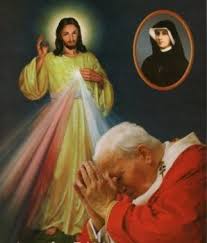
Divine Mercy – The message and devotion to Jesus is based on the writings of Saint Faustina Kowalska, a Polish nun who, in obedience to her spiritual director, wrote a diary of about 600 pages recording the revelations she received about God’s mercy. Even before her death in 1938, the devotion to The Divine Mercy had begun to spread. The message of mercy is that God loves us – all of us – no matter how great our sins. He wants us to recognize that His mercy is greater than our sins, so that we will call upon Him with trust, receive His mercy, and let it flow through us to others. Thus, all will come to share His joy. This devotion was approved by Pope St. John Paul II
E
East–West Schism – The Roman church divided medieval Christianity into Eastern (Greek) and Western (Latin) branches, which later became known as the Eastern Orthodox Church and the Roman Catholic Church, respectively.
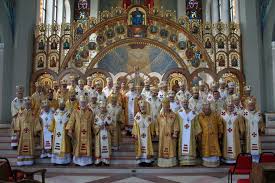
Eastern church leaders in union with Rome
Eastern Catholic Churches – historically called Uniate Churches, are 23 self-governing particular churches in full communion with the Pope, which make up the Catholic Church together with the Latin Church. Liturgies of the 23 Eastern Catholic churches include the Byzantine, Alexandrian, Armenian, East Syrian, and West Syrian Rites, traditions that are shared with other Eastern Christian churches, the Eastern Orthodox and Oriental Orthodox churches. Although some theological issues divide them from other Eastern churches, they admit members of the latter churches to the Eucharist and the other sacraments, as governed by canon law.
Eclesiastical judge (Latin: Judex -, or Judex Ecclesiasticus) is an ecclesiastical person who possesses ecclesiastical jurisdiction to deal with issues that come under his church jurisdiction.
Eminence – see: His Eminence (below)
Episcopal Conference – Conference of Bishops, or National Conference of Bishops is an official assembly of all the bishops of a given territory.
Episcopal see – the usual meaning of the phrase, the area of a bishop’s ecclesiastical jurisdiction
Episcopal vicar – is the principal deputy of the bishop of a diocese for the exercise of administrative authority and possesses the title of local ordinary.
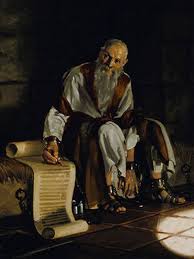
St Paul in chains writing an Epistle
Epistle – a writing directed or sent to a person or group of people, usually an elegant and formal didactic letter. The epistle genre of letter-writing was common in ancient Egypt as part of the scribal-school writing curriculum. The letters in the New Testament from Apostles to Christians are usually referred to as epistles. Those traditionally attributed to Paul are known as Pauline epistles, those attributed to Peter are known as Petrine or as catholic ( i.e., “general”) epistles.
Eternity -an infinite or an indeterminately long period of time.It is often referred to as the afterlife, everlasting life, life after death, the life to come, the life hereafter, the hereafter, the world hereafter, the afterworld, the next world, the beyond In classical philosophy, however, eternity is defined as what exists outside time. A circle is commonly used as a symbol for eternity –no beginning or end.
Eucharist – (pronunced: ˈyo͞okərist), a sacrament (Mass )containing the following elements: a commemoration of the Last Supper, the final meal that Jesus Christ shared with his disciples before his arrest, eventual crucifixion and resurrection.
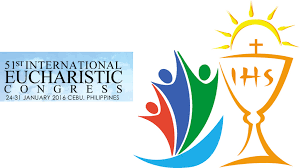 Eucharistic Congress – is a gathering of clergy, religious, and laity to bear witness to the Real Presence of Jesus in the Eucharist. Congresses bring together people from a wide area, and typically involve large open-air Masses, Eucharistic adoration (Blessed Sacrament), and other devotional ceremonies held over several days. Congresses may both refer to National (varies by country) and International Eucharistic Congresses. God willing, the next and 52nd International Eucharistic Congress, will take place in Budapest, Hungry in 2020
Eucharistic Congress – is a gathering of clergy, religious, and laity to bear witness to the Real Presence of Jesus in the Eucharist. Congresses bring together people from a wide area, and typically involve large open-air Masses, Eucharistic adoration (Blessed Sacrament), and other devotional ceremonies held over several days. Congresses may both refer to National (varies by country) and International Eucharistic Congresses. God willing, the next and 52nd International Eucharistic Congress, will take place in Budapest, Hungry in 2020
Eucharisic Service – The Church provides a rite for of Eucharistic service outside of Mass when priests are not available to celebrate same. This type of service is becoming more and more common across the worldwide church and here in Ireland. This rite was approved by Pope Paul in 1973 as there was need of it. There is, of course, no immediate consecration of the bread and wine but rather this has been done at a previous Mass.
The Eucharistic Service happens thus:
The people gather together to pray, to listen to the Word of God, to pray for the needs of our families and others, to remember the sick dying and dead,To pray the Our Father, exchange the sign of peace, to receive the previously consecrated Holy Communion, finally o pray a blessing for ourselves and our parish. In short, to worship our God as a parish community.
Excardination – Freeing a member of the clergy from one jurisdiction and being transferred to another. Incardination refers to a member of the clergy being placed under the jurisdiction of a particular bishop or other ecclesiastical superior.
Exclaustration is official authorisation for a religious bound by perpetual vows to live for a limited time outside their religious institute, usually with a view to discerning whether to depart definitively,
Excommunication – an institutional act of religious censure used to deprive, suspend, or limit membership in a religious community or to restrict certain rights within it, in particular receiving of the sacraments.
Exemption – the whole or partial release of an ecclesiastical person, corporation, or institution from the authority of the ecclesiastical superior.
Exorcism – (from Greek ἐξορκισμός, exorkismos – binding by oath) is the religious or spiritual practice of purportedly evicting demons or other spiritual entities from a person or an area they are believed to have possessed.
Faith – Trust, belief, confidence, conviction, credence, reliance or dependence in someone or something but it also allows for doubt. St Augustine prayed,’ O Lord , I believe, help my unbelief. It is numbered amongst the three theological virtues (faith, hope and love) meaning it is a free gift, infused into us through Divine grace. The theological virtues are so named because the object of these virtues is the divine being itself.
Faith, act of – c/f creed above
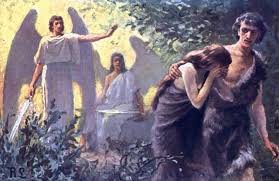 Fall of Man— or fall of humankind, the transition of the first human parents from a state of innocent obedience to God, to a state of guilty disobedience to God. depicted in the early chapters of the Book of Genesis
Fall of Man— or fall of humankind, the transition of the first human parents from a state of innocent obedience to God, to a state of guilty disobedience to God. depicted in the early chapters of the Book of Genesis
Family wage – a wage that is sufficient to raise a family. This contrasts with a living wage, (the minimum income necessary for a worker to meet their basic needs which is generally taken to mean a wage sufficient for a single individual to live on, but not necessarily sufficient to also support a family.) As a stronger form of living wage, a family wage is likewise advocated by proponents of social justice.
Father in Family – Male parent in a family
Father (cleric) — a traditional religious title given to ordained priests in the church.
Father (God) – God the Father is a title given to God, creator and preserver of life in various religions.
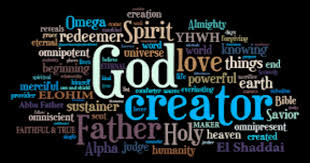 In Judaism, God is also described as the one, eternal, absolute, indivisible and incomparable, transcendent, immanent, and non-corporeal God of history.
In Judaism, God is also described as the one, eternal, absolute, indivisible and incomparable, transcendent, immanent, and non-corporeal God of history.
In Christianity, God the Father is regarded as the first person of the Holy Trinity, father of all peoples. Jesus referred to God sometimed as Abba – an Aramaic word that would most closely be translated as “daddy.” signifying their close, intimate relationship of a father with his child, as well as the childlike trust that a young child places in his “daddy.” c/f God, names of, below
Muslims believe that studying the various 99 names and attributes of Allah, (God) is one of the most effective ways of strengthening one’s relationship with God. Each Name and Attribute nourishes a kind of consciousness and humility in man and their study leads one to constantly better their actions. The Quran (Holy Book) says “The most beautiful names belong to Allah: so call on Him by them.” (Quran, 7:180). For example If one is asking for peace and tranquility in life while experiencing a period of tension, call on God by His name “As-Salaam,” meaning “The Ultimate Source of Peace.”
Feastdays -The calendar of saints of ‘Saints of the Day’ (www.catholicireland.net) is a traditional Christian method of organizing a liturgical year by associating each day with one or more saints and referring to the day as the feast day or feast of said saint. (The word “feast” in this context does not mean “a large meal, typically a celebratory one”, but instead “an annual religious celebration, a day dedicated to a particular saint”.) The system arose from the early Christian custom of commemorating each martyr annually on the date of his or her death, or birth into heaven, a date therefore referred to in Latin as the martyr’s dies natalis (“day of birth”). c/f Roman Martyrology below.
 Font – A holy water font or stoup is a vessel containing holy water generally placed near the entrance of a church or home. It is used in Catholic Church, Anglican Church, and some Lutheran churches by making the Sign of the Cross using the holy water upon entrance or exiting the church or home. Holy water is blessed by a priest and acts as a reminder of one’s baptism and baptismal promises.
Font – A holy water font or stoup is a vessel containing holy water generally placed near the entrance of a church or home. It is used in Catholic Church, Anglican Church, and some Lutheran churches by making the Sign of the Cross using the holy water upon entrance or exiting the church or home. Holy water is blessed by a priest and acts as a reminder of one’s baptism and baptismal promises.
Friars – members of one of the mendicant religious orders founded since the twelfth or thirteenth century that adopted a lifestyle of poverty, travelling, and living in urban areas for purposes of preaching, evangelization, and ministry, especially to the poor. These orders rejected the previously established monastic model of living in one stable, isolated community where members worked at a trade and owned property in common, including land, buildings and other wealth. By contrast, the mendicants avoided owning property, did not work at a trade, and embraced a poor, often itinerant lifestyle. They depended for their survival on the goodwill of the people to whom they preached. Some of the orders of friars are the Dominicans, Franciscans, Augustinians and Carmelites.
Full communion – a relationship between church organizations or groups that mutually recognize their sharing the essential doctrines. As a practical matter for most Catholics, full communion means that a member of one Church may partake of the Eucharist celebrated in another and for priests, that they may concelebrate the Eucharist with priests of another Church. Protestants understand full communion a matter of practical relations among denominations that nonetheless fully retain their distinct identities.
Funeral – a ceremony for honouring, respecting or sanctifying the life of a person who has died, and usually involves arrangements for the burial or cremation of their corpse. There are Funeral rite books available in www.Veritas.ie with appropriate prayers, hymns and scripture readings.
Funeral, Rites, Catholic are carried out in accordance with the prescribed rites of the Catholic Church. Such funerals are referred to in church canon law as
“ecclesiastical funerals.” In Catholic funerals, the normal procedure is to offer Mass (i.e. when this is appropriate, practical and available) for the benefit of the soul of the deceased and to provide condolence and comfort for the deceased’s family and exhort them to pray, along with the Church, for the soul of the departed. Catholic funerals services with prayers of intercession, appropriate hymns, but without Mass are becoming more regular. This should all be discussed with the family and the celebrant/minister.
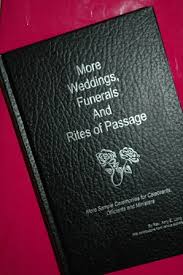 Funeral, Rites, Music – Music is integral to the funeral rites. It allows the community to express convictions and feelings that words alone may fail to convey. It has the power to console and uplift the bereaved and to strengthen the unity of the assembly in faith and love. The music at funerals should support, console and uplift the participants and should help to create in them a spirit of hope in Christ’s victory over death and in the Christian’s share in that victory.The ideal is to have music which reflects the Paschal mystery, hope and consolation, families often do request favourite music which they like. While the use of non-sacred music is not encouraged, it may be that the songs requested are not discordant with the Christian message. This should be discussed with the family and celebrant/minister.
Funeral, Rites, Music – Music is integral to the funeral rites. It allows the community to express convictions and feelings that words alone may fail to convey. It has the power to console and uplift the bereaved and to strengthen the unity of the assembly in faith and love. The music at funerals should support, console and uplift the participants and should help to create in them a spirit of hope in Christ’s victory over death and in the Christian’s share in that victory.The ideal is to have music which reflects the Paschal mystery, hope and consolation, families often do request favourite music which they like. While the use of non-sacred music is not encouraged, it may be that the songs requested are not discordant with the Christian message. This should be discussed with the family and celebrant/minister.
 God – the Supreme Being and principal object of our faith. The concept of God as described by theologians commonly includes the attributes of omniscience (infinite knowledge), omnipotence (unlimited power), omnipresence (present everywhere), omnibenevolence (perfect goodness), divine simplicity, and eternal and necessary existence. God is also usually defined as a non-corporeal being without any human biological gender, but the concept of God actively creating the universe has caused some religions to give “Him” the metaphorical name of “Father” (which is also a metaphor for humans being God’s stewards, supreme above all creation). Because God is conceived as being invisible from direct sight and not being a corporeal being, God cannot (some say should not) be portrayed in a literal visual image. Most images reflect how God interacts with the cosmos, earth, nature, and us humans as is reflected in the Holy Scriptures. Christians believe God to be Triune, Father, Son and Holy Spirit.
God – the Supreme Being and principal object of our faith. The concept of God as described by theologians commonly includes the attributes of omniscience (infinite knowledge), omnipotence (unlimited power), omnipresence (present everywhere), omnibenevolence (perfect goodness), divine simplicity, and eternal and necessary existence. God is also usually defined as a non-corporeal being without any human biological gender, but the concept of God actively creating the universe has caused some religions to give “Him” the metaphorical name of “Father” (which is also a metaphor for humans being God’s stewards, supreme above all creation). Because God is conceived as being invisible from direct sight and not being a corporeal being, God cannot (some say should not) be portrayed in a literal visual image. Most images reflect how God interacts with the cosmos, earth, nature, and us humans as is reflected in the Holy Scriptures. Christians believe God to be Triune, Father, Son and Holy Spirit.
God, Names of as found in – The Bible –
*The Old Testament refers to God as – Yahweh, Lord (or the tetragrammatonYHWH), Elohim, El-Shaddai, Yahweh, Jehovah and Adonai, I am whom I am, the Light, King of Kings, Lord of Lords and Lord of the Hosts. Hebrew names also include Elohim, (Lord God Almighty); El Elyon (The Most High God); Adonai (Lord, Master); Yahweh (Lord, … El-Shaddai, Yahweh, Jehovah and Adonai) Lord,Master (Lord God Almighty); (Lord God Almighty); El Elyon (The Most High God); Adonai (Lord, Master); Yahweh (Lord, … El Elyon (The Most High God); or Adonai (Lord, Master);
*The New Testament often refer to God as Father/Abba, Ancient of Days,. “The Most High”. (θεός the Greek term for God),Kyrios (i.e. Lord in Greek), Pateras (πατέρας i.e. Father in Greek), the Aramaic word “Abba” meaning “Father.” Jesus and Emmanuel that refer to Jesus have salvific attributes. The name Jesus is given in Luke 1:31 and Matthew 1:21 and in both cases the name is not selected by humans but is received by angelic messages with theological significance, e.g. the statement in Matthew 1:21 “you shall call His name Jesus, for He will save his people from their sins” associates salvific attributes to the name Jesus. Emmanuel (Mt 1:23). The names of the Father, Son and the Holy Spirit are inherently related in the New Testament, e.g. with Jesus’ instruction ‘baptizing them in the name of the Father and of the Son and of the Holy Spirit”. The Greek word pneuma, generally translated spirit, is found around 385 times in the New Testament. The English terms Holy Spirit and Holy Ghost have identical meanings, Three separate terms, namely Holy Spirit, Spirit of Truth and Paraclete are used in John 14:17, 15:26 and 16:13.
*Islamic faith , The Qur’an refers to – Allāh (Arabic term with no plural) meaning “the God”, or “the Deity”—is the most frequently used name of God in Islam. the Qur’an says ‘to Him Belong the Best Names’ (Lahu Al-Asmao Al-Husna), examples like Ar-Rahman (The Entirely Merciful), Ar-Rahim (The Especially Merciful).
*Hinduism– God may also be given a proper name in monotheistic currents of Hinduism which emphasize the personal nature of God, with early references to his name as Krishna-Vasudeva in Bhagavata or later Vishnu and Hari.
Grace – in theology grace has been defined as “a free gift of love and mercy given to us by God because He desires us to have it, and not because of anything we have done to earn it”, a spontaneous benevolence shown by God toward the human race”, generous, free and totally unexpected and undeserved” that takes the form of divine favor, love, clemency – a share in the divine life of God.
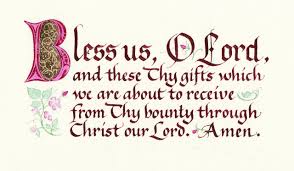 Grace – a prayer. Grace and thanksgiving imparts a blessing which sanctifies or thankful praise. It can be said before or after eating meal. Reciting such a prayer is often referred to as “saying grace”. A prayer of ‘Grace’ is said by the head of the house although any family member or an honoured guest may be asked to offer it before/after a meal:
Grace – a prayer. Grace and thanksgiving imparts a blessing which sanctifies or thankful praise. It can be said before or after eating meal. Reciting such a prayer is often referred to as “saying grace”. A prayer of ‘Grace’ is said by the head of the house although any family member or an honoured guest may be asked to offer it before/after a meal:
Before: Bless us, O Lord, and these your gifts, which from your bounty we are about to receive, through Christ our Lord. (Response ): Amen.
After: We give you thanks, Almighty God, for all your benefits, who live and reign world without end. (Response) Amen.
May the souls of the faithful departed, through the mercy of God, rest in peace. Amen.
 Heaven – this is the location of God’s abode, the throne of God and the beatific vision of the Lord, and the dwelling place of the angels The Scriptures tell us that the resurrected Jesus ascended to heaven where he now sits at the Right Hand of God the Father In traditional Christianity, heaven is also understood as the abode for the redeemed dead in the afterlife. According to Roman Catholic teaching, Mary, mother of Jesus, is also said to have been assumed into heaven. St Paul in 1 Corinthians 2:9 says “No eye has seen, no ear has heard, and no mind has imagined what God has prepared for those who love him.”
Heaven – this is the location of God’s abode, the throne of God and the beatific vision of the Lord, and the dwelling place of the angels The Scriptures tell us that the resurrected Jesus ascended to heaven where he now sits at the Right Hand of God the Father In traditional Christianity, heaven is also understood as the abode for the redeemed dead in the afterlife. According to Roman Catholic teaching, Mary, mother of Jesus, is also said to have been assumed into heaven. St Paul in 1 Corinthians 2:9 says “No eye has seen, no ear has heard, and no mind has imagined what God has prepared for those who love him.”
 Hell – The Roman Catholic Catechism n.1035 defines Hell as “a state of definitive self-exclusion from communion with God and the blessed.” One finds themselves in Hell as the result of dying in mortal sin without repenting and accepting God’s merciful love, becoming eternally separated from Him by one’s own free choice immediately after death. It is traditionally depicted as a place of torment and punishment in an afterlife,fiery and painful, inflicting guilt and suffering. It is said to be the permanent residence of the the fallen Angel Satan, the devil, the great deceiver, the evil one.
Hell – The Roman Catholic Catechism n.1035 defines Hell as “a state of definitive self-exclusion from communion with God and the blessed.” One finds themselves in Hell as the result of dying in mortal sin without repenting and accepting God’s merciful love, becoming eternally separated from Him by one’s own free choice immediately after death. It is traditionally depicted as a place of torment and punishment in an afterlife,fiery and painful, inflicting guilt and suffering. It is said to be the permanent residence of the the fallen Angel Satan, the devil, the great deceiver, the evil one.
Hierarchy –bishops, priests and deacons. In the ecclesiastical sense of the term, “hierarchy” commonly means the body of men who exercise authority within a Christian church. In the Catholic Church, authority rests chiefly with the bishop, while priests and deacons serve as their assistants, co-workers or helpers. It is also used to refer to bishops alone.
His Eminence – a style of reference for high nobility, still in use in various religious contexts. The style remains in use as the official style or standard of address in reference to a cardinal of the Roman Catholic Church, reflecting his status as a Prince of the Church. A longer, and more formal, title is “His (or Your when addressing the cardinal directly) Most Reverend Eminence”. Patriarchs of Eastern Catholic Churches who are also cardinals may be addressed as “His Eminence” or by the style particular to Eastern Catholic patriarchs, His Beatitude.
His Holiness – a style and form of address for supreme religious leaders, originally and most notably the Pope, Bishop of Rome and the leader of the worldwide Catholic Church. His Holiness (Latin: Sanctitas) is the official style used to address the Roman Catholic Pope and the Greek Orthodox Ecumenical Patriarch of Constantinople, as head of the Orthodox community. In February 2013, the Holy See announced that former Pope Benedict XVI would retain the style “His Holiness” after resigning and becoming Pope Emeritus.
Holy Communion – see: Eucharist (above)
Holy Days of obligation – major feasts of the Church’s year on which catholics are obliged to go to Mass. In the medieval period, days off work for the workforce in Catholic countries, consisted of Sundays and single days off on major feasts of the Church. So for the workers holyday, was the same as holiday. The Church has retained a number of its feasts, the major ones are known as Solemnities. Some of these Solemnities are known as ‘Holy days of Obligation’, when those who are able are expected to attend Mass.
Holy Days, Ireland – Immaculate Conception (8th December), Christmas Day (25th December), Epiphany (6th January ), St Patrick (17th March), Assumption of Our Lady (15th August), All Saints (1st November). In Ireland since October 1996, the Irish Bishops’ Conference removed the obligation on the feasts of Ascension and the Body and Blood of Christ (Corpus Christi), and the consequent transfer of these two feasts to the following Sundays in accordance with universal liturgical law. This decision has been confirmed by the Vatican Congregation for Divine Worship.
Holy Days worldwide
The Roman Catholic Church in the Latin rite has 10 obligatory holy days. With its approval the Apostolic See allows national Bishops’ Conferences to abolish the obligation of some of these or transfer them to Sundays. Immaculate Conception, Christmas Day, Mary Mother of God, Epiphany, St Joseph, Ascension of Jesus Sts Peter and Paul, Body & Blood of Christ (Corpus Christi), Assumption of Mary, All Saints.
 Holy Door – Year of Mercy (Latin: Porta Sancta) traditionally refers to an entrance portal located within the one or all the Papal Major basilicas in Rome. The doors are normally sealed by mortar and cement from the inside so that they cannot be opened. They are ceremoniously opened during Jubilee years designated by the Pope, for pilgrims who enter through those doors may piously gain the plenary indulgences attached with the Jubilee year celebrations. Since the year 1300 when Pope Boniface VIII declared the first Holy Year, the Catholic Church has regularly celebrated “Holy Years,” usually every twenty-five years (at least since 1470), except for special circumstances, like in 1983 when a Holy Year was declared to mark the 1950th anniversary of the death and resurrection of our Lord. A major aspect of the Holy Year has been that of pilgrimage to Rome to make reparation for sin and to renew the conversion of one’s life.
Holy Door – Year of Mercy (Latin: Porta Sancta) traditionally refers to an entrance portal located within the one or all the Papal Major basilicas in Rome. The doors are normally sealed by mortar and cement from the inside so that they cannot be opened. They are ceremoniously opened during Jubilee years designated by the Pope, for pilgrims who enter through those doors may piously gain the plenary indulgences attached with the Jubilee year celebrations. Since the year 1300 when Pope Boniface VIII declared the first Holy Year, the Catholic Church has regularly celebrated “Holy Years,” usually every twenty-five years (at least since 1470), except for special circumstances, like in 1983 when a Holy Year was declared to mark the 1950th anniversary of the death and resurrection of our Lord. A major aspect of the Holy Year has been that of pilgrimage to Rome to make reparation for sin and to renew the conversion of one’s life.
In October 2015, Pope Francis broke with tradition in having each Roman Catholic diocese throughout the world designate one or more local Holy Doors during the Extraordinary Jubilee of Mercy, so that Catholics could gain the plenary indulgences granted during the Jubilee year without having to travel to Rome. These ‘doors’ may take different forms. The year came to an end in November 201
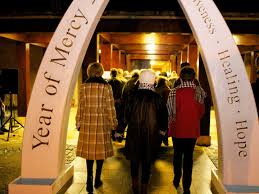
Holy Door, Ireland’s National Marian Shrine, Knock, Ireland
Holy Hour – an hour set aside for prayer and reflection either privately in a quiet or holy place. It can also refer to a hour of public prayer in a church or shrine with or without the blessed Sacrament exposed.
Holy Orders – in the church there are three degrees of sacramental orders: bishop, priest, and deacon. . In the phrase “holy orders”, the word “holy” means “set apart for some purpose.” “Orders” is simply a group within a hierarchical structure that is set apart for ministry in the Church. Ordination to the Diaconate typically happens in the last year of seminary training that a man will be ordained to the “transitional diaconate.” After six months or more as a transitional deacon, a man will be ordained to the priesthood. Priests are able to preach, perform baptisms, witness marriages, hear confessions and give absolution, anoint the sick, and celebrate the Eucharist or the Mass. Some priests go on to be chosen to be bishops.This distinguishes men bound for priesthood from those who have entered the “permanent diaconate” and do not intend to seek ordination as a priest.
Deacons, whether transitional or permanent, receive faculties to preach, to perform baptisms, and to witness marriages. They may assist at the Eucharist or the Mass, but are not the ministers of the Eucharist.
 Holy See – the Episcopal jurisdiction of the Bishop of Rome (the Pope), and is the preeminent episcopal see of the world wide Catholic Church, forming the central government of the Church. It is a very small independent sovereign entity. It serves as the central point of reference for the church everywhere and the focal point of communion due to its position as the pre-eminent episcopal see of the universal church. It traces its origin to the 1st century during the apostolic era, when Saint Peter arrived in Rome to evangelise and form a significant early Christian community of believers there. Today, it is responsible for the governance of all Catholics, organised in their particular Churches, Patriarchates and religious institutes.
Holy See – the Episcopal jurisdiction of the Bishop of Rome (the Pope), and is the preeminent episcopal see of the world wide Catholic Church, forming the central government of the Church. It is a very small independent sovereign entity. It serves as the central point of reference for the church everywhere and the focal point of communion due to its position as the pre-eminent episcopal see of the universal church. It traces its origin to the 1st century during the apostolic era, when Saint Peter arrived in Rome to evangelise and form a significant early Christian community of believers there. Today, it is responsible for the governance of all Catholics, organised in their particular Churches, Patriarchates and religious institutes.
As an independent sovereign entity, holding the Vatican City enclave in Rome as sovereign territory, it maintains diplomatic relations with an immense number of other states. It is viewed as analogous to a state while administered by the Roman Curia (Latin for Roman Court), similar to a centralised government with the Cardinal Secretary of State as its chief administrator, and various dicasteries, comparable to ministries and executive departments.
Holy Trinity– cf Trinity below
Holy Water – Holy water is water blessed by a pope, bishop, priest or deacon, and is used to bless oneself, others or other objects. It is also used as a reminder of our baptism.
 Holy Water font or stoup – a vessel containing holy water generally placed near the entrance of a church. It is used in Catholic Church, Anglican Church, and some Lutheran churches to make the Sign of the Cross using the holy water upon entrance to the church. Holy water is blessed by a priest or a deacon, and many Christians believe it to be a reminder of the baptismal promises.Many homes have a miniature version.
Holy Water font or stoup – a vessel containing holy water generally placed near the entrance of a church. It is used in Catholic Church, Anglican Church, and some Lutheran churches to make the Sign of the Cross using the holy water upon entrance to the church. Holy water is blessed by a priest or a deacon, and many Christians believe it to be a reminder of the baptismal promises.Many homes have a miniature version.
.
Honorary Prelate – of His Holiness is a priest to whom thePope has granted this title. They are addressed as Monsignor and have certain privileges as regards ecclesiastical dress
Hope -(latin spes) is one of the three theological virtues (Faith, Hope and Charity) in the Christian tradition. Hope being a combination of the desire for something and expectation of receiving it, it is ultimately the virtue is hoping for Divine union and eternal happiness. Like all virtues, it arises from the will, not the passions and is infused in us from/by God. The Christian who hopes seeks God for himself or herself. In technical language, the formal object of theological hope is God-as-possessed.
Hyperdulia — veneration of the Blessed Virgin Mary see also: dulia
Hypostasis —refers to the union of two natures divine and human, in the one divine person of the Son of God, Jesus Christ.
![]() Icons, religious – An icon is typically a painting or (technically) a writing depicting Christ, Mary, saints and/or angels, which is venerated. They are often referred to as windows to heaven or doorways to the sacred. All the materials are natural and have their spiritual meaning e.g Gold signifies light or holiness. Many icons are said to be written rather than painted.
Icons, religious – An icon is typically a painting or (technically) a writing depicting Christ, Mary, saints and/or angels, which is venerated. They are often referred to as windows to heaven or doorways to the sacred. All the materials are natural and have their spiritual meaning e.g Gold signifies light or holiness. Many icons are said to be written rather than painted.
Many of us close our eyes when we pray. Praying with icons is an ancient prayer practice that involves keeping our eyes wide open, taking into our heart what the image visually communicates. We focus not on what is seen in the icon, but rather on what is seen through it – the love of God expressed through God’s creatures. Look at the Icons you have chosen, or rather, let the Icons look, at you. Let the Icon of the Blessed Trinity, of God Incarnate, of His Mother, or of His Saints, or a Gospel ‘happening’ like the Nativity, speak to you as the large-eyed persons hold your attention. This is prayer without words, with a focus on being in God’s presence rather than performing in God’s presence.
Immaculate Conception — the dogma of the conception of the Blessed Virgin Mary (in the womb of her mother, St Anne), but free from original sin by God in virtue of the foreseen merits of her son Jesus Christ. – (not to be confused with the Incarnation of the Word of God)
Incardination — c/f excardination (above)
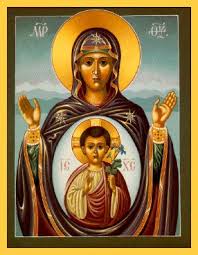 Incarnation of Christ— Latin ‘in carne’ enfleshment of The Word of God taking on a human nature and remaining God -becoming a true man named Jesus, Son of God and Mary, daughter of St Anne. This divine/human action is a central mystery of our faith
Incarnation of Christ— Latin ‘in carne’ enfleshment of The Word of God taking on a human nature and remaining God -becoming a true man named Jesus, Son of God and Mary, daughter of St Anne. This divine/human action is a central mystery of our faith
Institute of consecrated life – institutes or groupings in the Catholic Church whose members profess the evangelical counsels of chastity, poverty, and obedience as vows or other sacred bonds.
Institute, Religious — institutes, which are characterized by the public profession of vows, life in common as brothers or sisters, and separation from the world.
Institute, Secular — in which the members live in the world, and work for the sanctification of the world from withinee see: Secular institute (below)
Intercession/intercessory prayer – the act of praying to God on behalf of others. In Western Christianity, intercession forms a distinct form of prayer, alongside Adoration, Confession and Thanksgiving.
Jesus – (/ˈdʒiːzəs/; Greek: Ἰησοῦς Iesous; c. 4 BC to AD 30–33), was also referred to as: Jesus of Nazareth or Jesus Christ, the long awaited Messiah (or the Christ, the Anointed One) promised in the Old Testament.
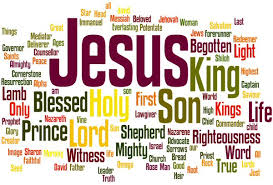 Jesus – Names of –There are over 200 of names of Jesus in the New Testament. Many of the names of Jesus come from the Gospels directly, others arose from his parables or sayings, others again came later on reflection.
Jesus – Names of –There are over 200 of names of Jesus in the New Testament. Many of the names of Jesus come from the Gospels directly, others arose from his parables or sayings, others again came later on reflection.
Emmanuel (God with us), the Christ, Lord, Master, Logos (the Word), Son of God, Son of Man, Son of David, Lamb of God, the New Adam, the Second Adam, Light of the world, King of the Jews, Rabboni, Rabbi, the Nazarene, “Chosen one” or “Elect one” The bread of Life, the way, the truth and the life, the Saviour and Redeemer, the good Shepherd and many more.
(His birth name could well have been pronounced Joshua, Yeshua, or even Isho or Isis from the Aramaic).
Jesus- Parables or Stories
From Nature
The Sower and the Seeds (Mark 4:3-9; Matt 13:3-9; Luke 8:5-8)
The Grain of Wheat (John 12:24)
The Weeds in the Grain or the Tares (Matt 13:24-30)
The Net (Matthew 13:47-50)
The Seed Growing Secretly (Spontaneously) or The Patient Husbandman (Mark 4:26-29)
The Mustard Seed (Matt13:31f.;Mark 4:30-32; Luke 13:18 f.)
The Leaven (Matthew 13:33; Luke 13:20 f.)
The Budding Fig Tree (Matt 24:32 f.; Mark 13:28 f.; Luke 21:19-31)
The Barren Fig Tree (Luke 13:6-9)
The Birds of Heaven (Matthew 6:26; Luke 12:24)
The Flowers of the Field (Matt 6:28-30; Luke 12:27f.)
The Vultures& the Carcass (Matt 24:28; Luke 17:37)
The Tree and its Fruits (Matthew 7:16; Luke 6:43-49)
The Weather Signs (Luke 12:54-56; cf. Matthew 26:2 f.; Mark 8:11-13)
From Work and Wages
Master and Servant (Luke 17:7-10)
The Servant Entrusted with Authority or The Faithful and Unfaithful Servants (Matt. 24:45-51; Luke 12:42-46)
The Waiting Servants (Luke 12:35-38; Mark 13:33-37)
The Laborers in the Vineyard or The Generous Employer (Matthew 20:1-16)
The Money in Trust or The Talents (Matthew 25:14-30; Luke 19:12-27)
The Lamp (Matt 5:14-16; Mark 4:21; Luke 8:16, 11:31) and The City Set on a Hill (Matt. 5:14b)
The Body’s Lamp (Matthew 6:22 f.; Luke 11:34-36)
The Discarded Salt (Matt 5:13; Mark 9:50; Luke 14:34 f.)
The Patch and the Wineskins (Matthew 9:16 f.; Mark 2:21 f.; Luke 5:36-39)
The Householder’s Treasure (Matthew 13:52)
The Dishonest Steward (Luke 16:1-12)
The Defendant (Luke 12:58 f.; Matthew 5:25 f.)
The Unforgiving Official or The Unmerciful Servant (Matthew 18:23-35)
The Rich Fool (Luke 12:16-21)
The Wicked Vinedressers (Matthew 21:33-41; Mark 12:1-9; Luke 20:9-16)
The Two Builders (Matthew 7:24-27; Luke 6:47-49)
The Two Debtors (Luke 7:41-43)
The Hidden Treasure (Matthew 13:44)
The Pearl of Great Price (Matthew 13:45 f.)
From Open or Closed door
The Closed Door (Luke 13:24-30)
The Doorkeeper (Mark 13:33-37; cf. Matt 24:42)
The Thief in the Night and the Faithful Servants (Matthew 24:42-51.; Luke 12:32-48.)
The Strong Man Bound (Matthew 12:29; Mark 3:27; Luke 11:21 f.)
The Divided Realm (Mark 3:24-26; Luke 11:17-20)
The Unoccupied House or The Demon’s Invasion (Matthew 12:43-45; Luke 11:24-26)
The Importunate Neighbor (Luke 11:5-8)
The Son’s Request (Matthew 7:9-11; Luke 11:11-13)
The Unjust Judge or The Importunate Widow (Luke 18:1-8)
The Pharisee and the Publican (Luke 18:9-14
From Weddings and Feasts
The SulkIng Children or The Children in the Marketplace (Matthew 11:16-19; Luke 7:31-35)
The Arrogant Guest (Luke 14:7-11)
The Bridegroom’s Friend (John 3:28)
The Bridegroom’s Attendants (Matthew 9:15a; Mark 2:18 f.; Luke 5:34)
The Bride’s Girlfriends or Ten Virgins (Matt25:1-13)
The Tower Builder and The Warring King (Luke 14:28-32)
The Wedding Feast or The Unwilling Guests (Matt 22:1-10; Luke 14:16-24)
The Wedding Garment (Matthew 22:11-14)
The Rich Man and Lazarus (Luke 16:19-31)
From Lost and found, Father and son themes
The Good Samaritan (Luke 10:25-37)
The Prodigal Son or The Loving Father (Luke 15:11-32)
The Two Sons, The Apprentice Son, and The Slave and Son (Matthew 21:28-32; John 5:19-20a; John 3:35)
The Lost Coin (Luke 15:8-10)
The Lost Sheep (Matthew 28:12-14; Luke 15:4-7)
The Shepherd, the Thief, and the Doorkeeper (John 10:1-18)
The Doctor and the Sick (Matthew 9:12; Mark 2:17; Luke 5: 31 f.)
The Great Assize or The Sheep and the Goats (Matthew 25:31-46)
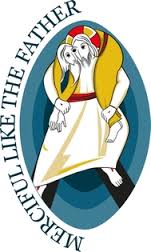 Jubilee Year of Mercy – (Latin: Iubilaeum Extraordinarium Misericordiae) is a Roman Catholic period of prayer held from the Feast of the Immaculate Conception (December 8), 2015 to the Feast of Christ the King (November 20), 2016. Like previous jubilees, it is seen by the Church as a period for remission of sins and universal pardon focusing particularly on God’s forgiveness and mercy. It is an extraordinary Jubilee because it had not been predetermined long before; usually ordinary jubilees take place every 25 years. The 2016 Jubilee was first announced by Pope Francis on March 13, 2015. It was declared in the Pope’s April 2015 papal bull of indiction,’ Misericordiae Vultus’ (Latin: “The Face of Mercy”). It is the 27th holy year in history, following the ordinary 2000 Jubilee during John Paul II papacy. The opening day was also the fiftieth anniversary of the closing of the Second Vatican Council.
Jubilee Year of Mercy – (Latin: Iubilaeum Extraordinarium Misericordiae) is a Roman Catholic period of prayer held from the Feast of the Immaculate Conception (December 8), 2015 to the Feast of Christ the King (November 20), 2016. Like previous jubilees, it is seen by the Church as a period for remission of sins and universal pardon focusing particularly on God’s forgiveness and mercy. It is an extraordinary Jubilee because it had not been predetermined long before; usually ordinary jubilees take place every 25 years. The 2016 Jubilee was first announced by Pope Francis on March 13, 2015. It was declared in the Pope’s April 2015 papal bull of indiction,’ Misericordiae Vultus’ (Latin: “The Face of Mercy”). It is the 27th holy year in history, following the ordinary 2000 Jubilee during John Paul II papacy. The opening day was also the fiftieth anniversary of the closing of the Second Vatican Council.
In prior months it was stressed that the Pontiff wishes the Jubilee to be celebrated not only in Rome but all around the world; for the first time holy doors are going to be opened in many dioceses across the world, either in the main cathedral or in local historical churches. The first holy door was opened by Pope Francis in Bangui on November 29, 2015 during a tour of East Africa (c/f Holy Doors above). Other doors have been opened since across the globe.
Judicial Vicar – (Latin:officialis) is an officer of the diocese who has ordinary power to judge cases in the diocesan ecclesiastical court.
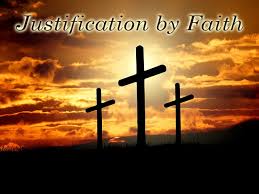 Justification by faith – is God’s act of removing the guilt and penalty of sin while at the same time declaring a sinner righteous i.e.being made righteous, just, holy, and acceptable before God through Christ’s atoning sacrifice. Protestantism protest that righteousness from God is viewed as being credited to the sinner’s account through faith alone, without works and they lean heavily on S Paul’s writing for support.
Justification by faith – is God’s act of removing the guilt and penalty of sin while at the same time declaring a sinner righteous i.e.being made righteous, just, holy, and acceptable before God through Christ’s atoning sacrifice. Protestantism protest that righteousness from God is viewed as being credited to the sinner’s account through faith alone, without works and they lean heavily on S Paul’s writing for support.
The Catholic Church maintains that St. James says we are justified by works as well as by faith. Is this not a contradiction? Not if we recognize that St. James is using the word “Justification” in a slightly different sense to that in which St. Paul uses it. Put very simply, Paul uses “justification” to mean to change from being “bad” in God’s sight (state of sin) to being “good” (state of grace). James, however, uses the same word to mean being kept good—and becoming even better—in God’s sight.
Just war theory (jus bellum iustum) is a doctrine, also referred to as a tradition, of military ethics studied by theologians, ethicists, policy makers, and military leaders. The purpose of the doctrine is to ensure war is morally justifiable through a series of criteria, all of which must be met for a war to be considered just.

Keys of the Kingdom – c/f Matthew 16:19. Jesus had asked His disciples who people thought He was. After responding with several of the more popular opinions, Jesus aimed His question directly at His disciples. Peter, responding for the twelve, acknowledged Jesus as the Christ, the Son of the Living God. After this great confession, Jesus replied, “Blessed are you, Simon Bar-Jonah! For flesh and blood has not revealed this to you, but my Father who is in heaven. And I tell you, you are Peter, and on this rock I will build my church, and the gates of hell shall not prevail against it. I will give you the keys of the kingdom of heaven, and whatever you bind on earth shall be bound in heaven, and whatever you loose on earth shall be loosed in heaven” (Matt 16:17-19).
Keys are used to lock or unlock doors. In this text, Jesus is laying the foundation of His church (Ephesians 2:20). The disciples will be the leaders of this new institution, and Jesus is giving them the authority to, as it were, open the doors to heaven and invite the world to enter.
Kiss of peace – an ancient traditional Christian greeting. Also called “Holy kiss”, “Brother kiss” among men, or “Sister kiss” among women. Some congregations do not perform inter-gender holy-kissing. The practice remains a part of the worship in traditional churches where it is often called the kiss of peace, sign of peace, Holy kiss or simply peace or pax.
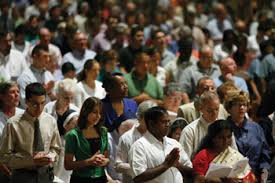 Laity – There are estimated to be over one billion Roman Catholics in the world. The majority of these are lay Catholics, also known as the laity, which includes all Roman Catholics, except those who are part of the clergy. These faithful are by baptism made one body with Christ and are constituted among the People of God; they are in their own way made sharers in the priestly, prophetical, and kingly functions of Christ; and they carry out for their own part the mission of the whole Christian people in the Church and in the world
Laity – There are estimated to be over one billion Roman Catholics in the world. The majority of these are lay Catholics, also known as the laity, which includes all Roman Catholics, except those who are part of the clergy. These faithful are by baptism made one body with Christ and are constituted among the People of God; they are in their own way made sharers in the priestly, prophetical, and kingly functions of Christ; and they carry out for their own part the mission of the whole Christian people in the Church and in the world
Lapsed Catholic — a Catholic who has ceased believing the teaching or practicing the Catholic faith. Such a person is said to have lapsed from all or some of the faith. (‘a la carte Catholic’) Such a person may still identify as a Catholic and remains a Catholic.
Last Rites- The Sacrament of the Anointing of the sick is no longer referred to as the last rites or Extreme Unction as its use has been extended to all those who are seriously sick and not just the dying. It is a ritual of healing appropriate not only for physical but also for mental and spiritual sickness. c/f Anointing of the Sick above.
Latin Church – a group of Christian faithful united by a hierarchy according to the norm of law which the supreme authority of the Church expressly or tacitly recognizes as ‘sui iuris’. There are several such ‘sui iuris’ particular churches within the Catholic Church. Sui iuris, is a Latin phrase which literally means “of one’s own right”
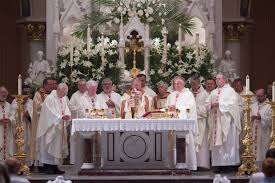 Latin Rites – liturgical rites used within that area of the Catholic Church where the Latin language once dominated. Their number is now much reduced. In the aftermath of the Council of Trent, in 1568 and 1570 Pope Pius V suppressed the Breviaries and Missals that could not be shown to have an antiquity of at least two centuries. Many local rites that remained legitimate even after this decree were abandoned voluntarily, especially in the 19th century. In the second half of the 20th century. A few such liturgical rites persist today for the celebration of Mass, since 1965-1970 in revised forms, but the distinct liturgical rites for celebrating the other sacraments have been almost completely abandoned. The Roman Rite is by far the most widely used. Like other liturgical rites, it developed over time, with newer forms replacing the older. c/f Tridentine Mass Rite
Latin Rites – liturgical rites used within that area of the Catholic Church where the Latin language once dominated. Their number is now much reduced. In the aftermath of the Council of Trent, in 1568 and 1570 Pope Pius V suppressed the Breviaries and Missals that could not be shown to have an antiquity of at least two centuries. Many local rites that remained legitimate even after this decree were abandoned voluntarily, especially in the 19th century. In the second half of the 20th century. A few such liturgical rites persist today for the celebration of Mass, since 1965-1970 in revised forms, but the distinct liturgical rites for celebrating the other sacraments have been almost completely abandoned. The Roman Rite is by far the most widely used. Like other liturgical rites, it developed over time, with newer forms replacing the older. c/f Tridentine Mass Rite
Laws of the Church – Canon Law of the Catholic Church (Ecclesiastical Latin: Jus Canonicum) is the system of laws and legal principles made and enforced by the hierarchical authorities of the Church to regulate its external organization and government and to order and direct the activities of Catholics toward the mission of the Church. c/f Canon law above
Lay Ecclesial Ministry is the term adopted by the United States Conference of Catholic Bishops to identify the relatively new category of pastoral ministers in the Catholic Church who serve the Church but are not ordained. Lay ecclesial ministers are co-workers with the bishop alongside priests and deacons. He/she is an individual who wishes to serve the Church while remaining in secular employment. He/ she is required to attend a programme of training to enhance his/her biblical knowledge, theology and worship and, of course, how to conduct a Service for which there are strict guidelines. Upon successful completion of the programme, he/she is commissioned as a lay Minister. A Mass has the important aspect of the Consecration of bread and wine to the body and blood of Christ. Neither a Lay Minister nor a Deacon is authorized to consecrate
Lectio Divina – (Latin for “Divine Reading”) is a traditional Benedictine practice of scriptural reading, meditation and prayer intended to promote communion with God and to increase the knowledge of God’s Word. It does not treat Scripture as texts to be studied, but as the Living Word.
Traditionally, Lectio Divina has four separate steps: read; meditate; pray; contemplate. First a passage of Scripture is read, then its meaning is reflected upon. This is followed by prayer and contemplation on the Word of God. The focus of Lectio Divina is not a theological analysis of biblical passages but viewing them with Christ as the key to their meaning.
Lectionary is a book or listing that contains a collection of scripture readings appointed for worship on a given day or occasion.
Lector – a reader is responsible for reading aloud excerpts of the scripture at a liturgy. He reads from a lecturn c/f (below)
Lecturn – the place or stand from which a lector reads his assigned scripture text.
Legion of Mary -(Latin: Legio Mariae) is an international association of the faithful of the Catholic Church who serve the Church on a voluntary basis. It was founded in Dublin, Ireland, as a Roman Catholic Marian Movement by layman Frank Duff. Today between active and auxiliary (praying) members there are over 10 million members worldwide making it the largest apostolic organization of lay people in the Catholic Church. Membership is highest in South Korea, Philippines, Brazil, Argentina and the Democratic Republic of Congo. These countries have between 250,000 and 500,000 members each.
To be in the Legion of Mary, one must be a practicing Catholic. Active members serve God under the banner of Mary by practicing the Spiritual Works of Mercy. The main apostolate of the Legion consists in activities directed towards all men and women, young and old, rich and poor as well as people from the margins of society (homeless, prostitutes, prisoners etc.) and towards non-Catholics. The members of the Legion are primarily engaged in the performance of the Spiritual Works of Mercy rather than works of material aid
Limbo — from the Latin limbus, edge or boundary, referring to the “edge” of Hell. It is a speculative idea about the afterlife condition of those who die in original sin. Medieval theologians of western Europe described the afterworld/underworld as divided into four distinct parts: Hell of the Damned, Purgatory, Limbo of the Fathers or Patriarchs, and Limbo of the Infants. Limbo is not an official doctrine of the Roman Catholic Church nor is it mentioned in the1994 or 1997 Cathechism of the Catholic Church. It is important to stress that all children are children of God. We canconfidently entrust all such clildren, born, unborn, baptised and unbaptisd to God’s loving kindness and endless mercy
Liturgical Colours – refer to the colour of church vestments and altar appendages that appear in connection with different seasons of the liturgical year. i.e. Ordinary time: green, Advent and Lent purple c/f Liturgial Seasons (below)
Liturgical Seasons – The liturgical, Church or Christian year, consists of the cycle of liturgical seasons that determine when feast days, including celebrations of saints, are to be observed, and which portions of Scripture are to be read either in an annual cycle or in the Sunday cycle of three years. The Catholic Church sets aside certain days and seasons of each year to recall and celebrate various events in the life of Christ. In its Roman Rite the liturgical year begins with Advent, the time of preparation for both the celebration of Jesus’ birth, and his expected second coming at the end of time. This season lasts from four Sundays before Dec 24(Christmas Eve). Christmastide follows, beginning with First Vespers of Christmas on the evening of 24 December and ending with the Feast of the Baptism of the Lord. Lent is the period of purification and penance that begins on Ash Wednesday and ends on Holy Thursday. The Holy Thursday evening Mass of the Lord’s Supper marks the beginning of the Easter Triduum, which includes Good Friday, Holy Saturday, and Easter Sunday. The days of the Easter Triduum recall Jesus’ Last Supper with his disciples, death on the cross, burial, and resurrection. The seven-week liturgical season of Eastertime immediately follows the Triduum, climaxing at Pentecost. This last feast recalls the descent of the Holy Spirit upon Jesus’ disciples after the Ascension of Jesus. The rest of the liturgical year is commonly known as Ordinary Time when we reflect on the words and actions of Jesus while he preached to his followers and trained the Twelve apostles.
Latria — worship, adoration, reverence or prayer owed/directed to God alone. It carries an emphasis on the internal form of worship. A most common use of latria in the Church is adoration of the Lord in/at the Eucharist.
Liturgy – (Greek: λειτουργία) is the customary public worship – a communal response to the sacred through activity reflecting praise, thanksgiving, supplication, or repentance.
Liturgical seasons –
Local ordinary – local hierarchy or local church authority is the bishop of the area. Priests and deacons are his assistants.
M
Mass – the usual English-language name for the Eucharistic celebration in the Latin liturgical rites of the Catholic Church
Mass on Internet/TV – The first thing to remember is that a televised Mass is not a substitute for assisting at Mass within a parish faith community and does not fulfill the Sunday precept. If you truly cannot go to a physical Mass, then the obligation is suspended.
If you are sick, you don’t have to fulfill the obligation. If you are old and afraid to go out alone, or that you might slip on the ice, you don’t have to fulfill the obligation. If you are far from a church while travelling and don’t know where to go or can’t get to a church, you don’t have to fulfill the obligation. If you are taking care of a sick person and cannot leave, you are not obliged to go to Mass.
The 1983 Code of Canon Law, in can. 1245 gives to pastors or “the parish priest” the ability to grant a dispensation from the obligation in individual cases or else to commute the obligation to other pious works. You can debate whether or not watching Mass on TV or the internet counts as a “pious work”.
The limitation of the medium of Internet/television “with its inherent lack of physical interaction with others can lead people to more passive roles as spectators.” But the benefits for those who make use of it outweigh the dangers involved. Many regard televised liturgies as a means of evangelization, of sharing the Good News of Jesus Christ and promoting the Church’s worship via modern means of communication (cf. Church Document “Inter Mirifica,” No. 14).”
Live transmission is practically the only form contemplated in the Italian norms due to the particular Italian situation in which Mass is transmitted live every Sunday by one of the national public television stations, either from the Vatican or from a different church or cathedral every week. A next-best solution is the delayed telecast, which is the taping of a Sunday Mass and its transmission on the same day. The least satisfactory solution, to be avoided if possible, is the pre-recorded telecast. Viewers must be informed that it is pre-recorded and has certain limitations such as having been celebrated outside the liturgical day or season. The guidelines give as an example the “taping of ‘Christmas morning Mass’ on Monday of the fourth week of Advent.”
Mass, Order of – The “Order of Mass” is based on the Missale Romanum (The Roman Missal, revised by Decree of the Second Vatican Council and published by authority of Pope Paul VI). They are
1. Introductory Rites,
2. Liturgy of the Word : (Biblical Readings, Homily, Creed, Intercessions),
3. Liturgy of the Eucharist: (Preparation, Eucharistic Prayer; Communion Rite), and
4. Concluding Rite; final prayer, blessing and dismisal
Mariology— the theology concerned with the Virgin Mary, the mother of Jesus Christ.
Mary, Names of – According to the New Testament, Mary (Aramaic: Mariam; Hebrew: Miriam; also known as Saint Mary, the Virgin Mary, Our Lady, and the Madonna woman of Nazareth and the mother of Jesus. To distinguish her from the many other Marys appearing in the gospels, she is a often referred to as “Mary, mother of Jesus”.
Mediatrix — the role of the Blessed Virgin Mary as a (female human) mediator in the salvation process, “This intercessory role is to be so understood that it neither takes away from nor adds anything to the dignity and efficaciousness of Christ the one Mediator.
Metropolitan bishop – A Latin Church Metropolitan is the bishop of the principal (the “metropolitan”) see of an ecclesiastical province composed of several dioceses. He receives a pallium from the pope as a symbol of his office. The metropolitan bishop has limited oversight authority over the suffragan dioceses in their province, including ensuring that the faith and ecclesiastical discipline are properly observed.
Military ordinariate – an ecclesiastical jurisdiction responsible for the pastoral care of Catholics serving in the armed forces of a nation.
Miracles – an event not explicable by natural or scientific laws – a phenomenon not explained by known laws of nature. Such an event may be attributed to a supernatural being (a deity), magic, a miracle worker, a saint or a religious leader. The gospels record three sorts of miracles performed by Jesus: exorcisms, cures, and nature wonders. In the Gospel of John the miracles are referred to as “signs” and the emphasis is on God demonstrating his underlying normal activity in remarkable ways. In the New Testament, the greatest miracle is the resurrection of Jesus, the event central to Christian faith.
Missal – a liturgical book containing all instructions and texts necessary for the celebration of Mass or Eucharist throughout the year.
Missal, Roman – Roman Missal (Latin: Missale Romanum) is the liturgical book that contains the texts and rubrics for the celebration of the Mass in the Roman Rite of the Catholic Church.
Mitre – Greek: μίτρα, “headband” or “turban”), is part of ceremonial head-dress of bishops and certain abbots in traditional Christianity; continuing the priestly practice of Temple Judaism. They are worn in the Orthodox Church, Roman Catholic Church, as well as in the Anglican Communion, some Lutheran churches, and also bishops and certain other clergy in the Eastern Catholic Churches and the Oriental Orthodox Churches.
Monk (from Latin monachus) is a person who practices religious asceticism, living either alone or with any number of other monks. A monk may be a person who decided to dedicate his life to serving all other living beings, or to be an ascetic who voluntarily chooses to leave mainstream society and live his life in prayer and contemplation. The concept is ancient and can be seen in many religions and in philosophy. In modern English the term monk is mainly in use for men. The word nun is typically used for female monastics.
Monsignor – (english pronunciation: ‘mon-see-knor’) is an honorific form of address for those members of the clergy of the Catholic Church including bishops, honorary prelates and canons. In some cases, these ecclesiastical honorific titles derive from the pope, but in other cases it is simply a customary or honorary style belonging to a prelate or honorary prelate. These are granted to individuals who have rendered valuable service to the Church, or who provide some special function in Church governance, or who are members of bodies such as certain chapters. It is abbreviated Mgr, Msgr, or Mons.Mortal Sin –c/f Sin mortal (below)
Most Holy Trinity — see:Trinity (below), or Holy Trinity (above)
N
Names of God – c/f God, names of above
Nave – the main body of the church. It provides the central approach to the high altar. The term nave is from medieval Latin navis (ship). A ship was an early Christian symbol.
Narthex is an architectural element of a church building consisting of the entrance or lobby area, located at the west end of the nave, opposite the church’s main altar.
Novice – is a prospective member of a religious institute who is being tried and being proven for suitability of admission to a religious order of brothers, sisters or monks. They are not admitted to vows until they have successfully completed the prescribed period of training and proving. The legislated length and conditions by which anyone aspiring to become a monk or religious is obliged to be a novice is normally at least one year.
Nicene Creed – c/f Creed (above)
Novitiate – a separate areas within a monasteryor convent where novices housed and trained while preparing for making their religious vows
Nun – a member of a religious community of women, typically one living under vows of poverty, chastity, and obedience. She may have decided to dedicate her life to serving all other living beings, or she might be an ascetic who voluntarily chose to leave mainstream society and live her life in prayer and contemplation in a monastery or convent. While in common usage the terms “nun” and “sister” are often used interchangeably (the same title of “Sister” for an individual member of both forms), they are considered different ways of life, with a “nun” being a religious woman who lives a contemplative and cloistered life of meditation and prayer for the salvation of others, while a “religious sister”, in religious institutes like Mother Teresa’s Missionaries of Charity, lives an active vocation of both prayer and service, often to the needy, ill, poor, and uneducated.
Nuncio (officially known as an Apostolic nuncio and also known as a papal nuncio) is the title for an ecclesiastical diplomat, being an envoy or permanent diplomatic representative of the Holy See to a state or international organization. A nuncio is appointed by and represents the Holy See, and is the head of the diplomatic mission, called an Apostolic Nunciature, which is the equivalent of an embassy. A nuncio is usually an archbishop. He performs the same functions as an ambassador and has the same diplomatic privileges.
Officialis — c/f Judicial vicar (above)
Order of Mass c/f Mass, Order of, (above)
Order, Religious — c/f Religious order (below)
Ordinariate, Military — c/f Military ordinariate (above)
Ordinariate, Personal — c/f Personal ordinariate (below)
Ordinary — c/f Local ordinary (above)
Papal or (Pontifical) Family or Household – (Latin: Domus Pontificalis), called until 1968 the Papal Court (Pontificalis Aula). consists of ecclesiastics at the Holy See who participate in religious ceremonies (Cappella Pontificia) . Historically, they chanted divine service daily in the papal palace, with the Pope in person celebrating or assisting at Pontifical Mass on certain days. The Familia Pontificia), which assists the pope as a juridical body with civil functions.
Parables or Stories of Jesus – c/f Jesus parables above
Parish – (Latin: parochus) is a stable community of the faithful within a diocese headed by a bishop, whose pastoral care has been entrusted to a parish priest (Latin: pastor), under the authority of the bishop. It is the primary constituent unit of a diocese.Most parishes are territorial parishes, which comprise all Catholics living within a defined geographic area. A parish may be joined with others in a deanery or vicariate forane and overseen by a vicar forane, also known as a dean or archpriest. As per canon 518, a bishop may also erect non-territorial parishes, or personal parishes, within his diocese.
Parish priest – (Latin: pastor), is under the authority of the bishop. It is the primary constituent unit of a diocese. They are also created to better serve Catholics of a particular rite, language, nationality, or other commonality which make them a distinct community.
Pastor – The word “pastor” derives from the Latin noun pastor which means “shepherd” and relates to the Latin verb pascere – “to lead to pasture, set to grazing, cause to eat”. The term “pastor” also relates to the role of elder within the New Testament, but is not synonymous with the biblical understanding of minister. Many Protestant churches call their ministers “pastors”. Bishops in Western Christianity often bear a formal crosier in the form of a stylised shepherd’s crook as a symbol of their pastoral/shepherding functions.
Patron Saint – a saint who in Roman Catholicism and Eastern Orthodoxy is regarded as the heavenly advocate, protector or guardian of a nation, place, craft, activity, class, clan, family, person or any area of our lives. They are sometimes nominated by popes but not necessarily. Anyone can select any saint as a patron. e.g St Joseph, when one is moving house. It is connected to the idea of the communion of saints.
Penance – see: Sacrament of Penance (below)
Permanent deacon – see: Deacon (above)
Personal Ordinariate – often called a “personal ordinariate for former Anglicans or more informally an “Anglican ordinariate”, is a canonical structure within the Catholic Church established in accordance with the apostolic constitution, Anglicanorum Coetibus of 4 November 2009and its complementary norms.The ordinariates were established in order to enable “groups of Anglicans” to join the Catholic Church while preserving elements of their liturgical and spiritual patrimony. They are juridically equivalent to diocese, “a particular church in which and from which exists the one and unique Catholic Church, but may be erected in the same territory as other dioceses “by reason of the rite of the faithful or some similar reason.”
Personal prelature – a canonical structure which comprises a prelate, clergy and laity who undertake specific pastoral activities. The first, and thus far the onlypersonal prelature is Opus Dei. Personal prelatures, similar to dioceses and military ordinariates, are under the governance of the Vatican’s Congregation for Bishops.
Pew – a long bench seat or enclosed box, used for seating members of a congregation or choir in a church or sometimes a courtroom.
Pontiff – from Latin pontifex, a word commonly held to come from the Latin root words pons (bridge) + facere (to do, to make), and so to have the literal meaning of “bridge-builder”. Most commonly it refers to the Bishop of Rome, the Pope- the Supreme Pontiff.
Prayer – (Latin precari “to ask earnestly, beg, entreat”) is an invocation or act that seeks to connect with God or some holy person Prayer may be directed towards a deity, spirit, holy or deceased person, for the purpose of worshipping, requesting guidance, requesting assistance, confessing transgressions (sins) or to express one’s thoughts and emotions. Thus, people pray for many reasons such as personal benefit, asking for divine grace, spiritual connection, or for the sake of others.
Prayer may be either individual or communal and take place in public or in private. It may involve the use of words, song or complete silence. When language is used, prayer may take the form of a hymn, incantation, formal creedal statement, or a spontaneous utterance in the praying person.
Prayer online – An online invitation to make a ‘Sacred Space’ in your day, praying here and now, as you visit this website, with the help of scripture chosen every day and on-screen c/f www.sacredspace.ie/
Prayer, Intercessory – c/f Intercession above
Predestination and Free will – predestination is, “God’s act of decreeing or foreordaining events from eternity or, from eternity, whatever comes to pass. It is used particularly in theology to denote the preordination of people to everlasting happiness or misery. Free will is our ability to make choices according to our desire. God’s predestination does not mean that we cannot make free will choices. God predestines in and through our choices because God is all-knowing and all-powerful. He knows what we will do because He knows all things. He cannot not know all things. So, whatever you choose to do out of your own free volition is known. But His knowing doesn’t mean you don’t freely choose.
An illustration would be that I could arrange for my child to choose ice cream over something else and not violate his free will. For instance, I could put a bowl of chocolate ice cream and a bowl of dirt and rocks in front of my child, and I know exactly which one the child will choose to eat. But my knowing does not violate my child’s free will.
Prelate is a high-ranking member of the clergy who is an ordinary or who ranks in precedence with ordinaries. The word derives from the Latin prælatus, “be set above or over” or “prefer”; hence, a prelate is one set over others. The archetypal prelate is a bishop, whose prelature is his particular church. All other prelates, including the regular prelates such as abbots and major superiors, are based upon this original model of prelacy.
Prelate, Honorary – see: Honorary Prelate (above)
Prelature, Personal – see: Personal prelature (above)
Prelature, Territorial – see: Territorial prelature (below)
Presbytery – (residence), a clergy house, especially for the home of one or more Roman Catholic priests.
Presbyterium – a body of ordained, active priests in the Roman Catholic or Anglican churches or a body of Church elders and ministers, especially (in Presbyterian Churches) an administrative body (court) representing all the local congregations of a district.
Priest – The ministerial orders of the Church are those of bishop, presbyter (priest in English), and deacon. All the baptized faithful share the common priesthood with Jesus Christ himself. All who, through the Sacrament of Holy Orders, share in the person of Christ, the Head of His Body, the Church. Their priesthood is thus different in function and essence. “The Latin word ‘sacerdos’ is used to refer in general to the ministerial priesthood shared by bishops and presbyters. An ordained priest is commonly addressed with the title “Father”.
Priest, Diocesan – see: Diocesan priest (above)
Priest, Religious – see: Regular clergy (below)
Prior –derived from the Latin for “earlier, first”, (or prioress for nuns) is an ecclesiastical title for a superior, usually lower in rank than an abbot or abbess. Its earlier generic usage referred to any monastic superior. c/f Abbot above
Prophet – an individual who has claimed to have been contacted by the supernatural or the divine, and to speak for them, serving as an intermediary with humanity, delivering this newfound knowledge from the supernatural entity to other people. The message that the prophet conveys is called a prophecy, which transports —at least in Judaism— a message beyond mere pagan soothsaying, augury, divination, or forecasting, and, often comprises issues of social justice.
Claims of prophet-hood have existed in many cultures through history, including Judaism, Christianity, Islam, in Ancient Greece, Zoroastrianism, Manichaeism and many others. Traditionally, prophets are regarded as having a role in society that promotes change due to their messages and actions which can convey the displeasure of God for the behaviour of people.
Providence, Divine – the foreseeing care and guidance of God over nature all the creatures of the earth and us with wise loving benevolence.
Psalms, Book of – (Hebrew: תְּהִלִּים or תהילים, Tehillim, “praises”), c The Book of Psalms commonly referred to simply as Psalms or “the Psalms”, is the first book of the “Writings”, the third section of the Hebrew Bible, and a book of the Christian Old Testament. The title is derived from the Greek translation, ψαλμοί psalmoi, meaning “instrumental music” and, by extension, “the words accompanying the music.” The book is an anthology of individual psalms, with 150 in the Jewish and Western Christian tradition and more in the Eastern Christian churches. Many of the psalms are linked to the name of King David, although his authorship is not accepted by some modern Bible scholars. They are a great source of support and consolation e.g. Ps 24 the Good Shepherd Psalm
Pulpit – see: Ambo (above)
Quinque Viæ — St Thomas Aquinas’ famous five logical philosophical arguments for the existence of God found in his Summa Theologiæ in the 13th Century
1. The Argument of the Unmoved Mover
Summary: In the world we can see that at least some things are changing. Whatever is changing is being changed by something else. If that by which it is changing is itself changed, then it too is being changed by something else. But this chain cannot be infinitely long, so there must be something that causes change without itself changing. This everyone understands to be God.[
2. The Argument of the First Cause:
Summary In the world we can see that things are caused. But it is not possible for something to be the cause of itself, because this would entail that it exists prior to itself, which is a contradiction. If that by which it is caused is itself caused, then it too must have a cause. But this cannot be an infinitely long chain, so therefore there must be a cause which is not itself caused by anything further. This everyone understands to be God.
3. The Argument from Contingency
Summary: In the world we see things that are possible to be and possible not to be. In other words, perishable things. But if everything were contingent and thus capable of going out of existence, then, given infinite time, this possibility would be realized and nothing would exist now. But things clearly do exist now. Therefore, there must be something that is imperishable: a necessary being. This everyone understands to be God
4. The Argument from Degree
Summary: We see things in the world that vary in degrees of goodness, truth, nobility, etc. For example, sick animals and healthy animals, and well drawn circles as well as poorly drawn ones. But judging something as being “more” or “less” implies some standard against which it is being judged. Therefore, there is something which is goodness itself, and this everyone understands to be God.
5.The Teleological Argument
Summary: We see various non-intelligent objects in the world behaving in regular ways. This cannot be due to chance, since then they would not behave with predictable results. So their behavior must be set. But it cannot be set by themselves, since they are non-intelligent and have no notion of how to set behavior. Therefore, their behavior must be set by something else, and by implication something that must be intelligent. This everyone understands to be God.
‘Ratum sed non consummatum’ – (Latin phrase: ratified but not consummated) refers to a specific type of marriage in Catholic matrimonial canon law. If a matrimonial celebration takes place (ratification) but the spouses have not yet engaged in intercourse (consummation), then the marriage is said to be a marriage ‘ratum sed non consummatum.’ The Tribunal of the Roman Rota has exclusive competence to dispense from marriages ‘ratum sed non consummatum’, which can only be granted for a ‘just reason.’
Reader – an appointed person who is responsible for reading aloud excerpts of the scripture at a liturgy. In early Christian times, the reader was of particular value due to the rarity of literacy.
Reconciliation – see: Sacrament of Penance (below)
Rector – an ecclesiastical sense, a cleric who functions as an administrative leader in some Christian denominations.
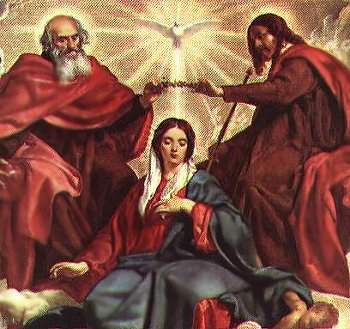 Regina Coeli – The Regina Coeli prayer is recited in place of the Angelus during the Easter season, from Holy Saturday through Pentecost.The text of the devotion:
Regina Coeli – The Regina Coeli prayer is recited in place of the Angelus during the Easter season, from Holy Saturday through Pentecost.The text of the devotion:
Queen of Heaven, rejoice, alleluia.
The Son whom you merited to bear, alleluia.
Has risen, as He said, alleluia.
Pray for us to God, alleluia.
V. Rejoice and be glad, O Virgin Mary, alleluia.
R. For the Lord has truly risen, alleluia.
Let us pray.
O God, who through the resurrection of your Son Jesus Christ
gave rejoicing to the world
grant, we pray, that through his Mother, the Virgin Mary,
we may obtain the joys of everlasting life.
Through Christ our Lord. Amen.
Regular clergy, or just regulars, is applied to clerics who follow a “rule” (Latin regula) in their life, those who are members of religious institutes. Formerly, it meant those who were members of Catholic religious orders, institutes in which at some least of the members made solemn profession.
Relics of saints – the Bible condones the veneration of relics – parts of the bodies of holy people. In the Old Testament, the Second Book of Kings records that a dead man was brought back to life when his corpse came into contact with the bones of the great prophet Elisha (cf. II Kings 13:20-21). The Acts of the Apostles describe how pieces of cloth that had touched St. Paul’s skin were used to heal the sick and cast out evil spirits (cf. Acts 19:11-12). By the second century, the veneration of relics was already a widespread Christian practice. After St. Polycarp of Smyrna had been burnt at the stake, for example, his faithful disciples carried off his remains. “We took up his bones,” they later recorded, “which are more valuable than precious stones and finer than refined gold, and laid them in a suitable place, where the Lord will permit us to gather ourselves together, as we are able, in gladness and joy, and to celebrate the birthday of his martyrdom.” But even if modern secularism considers relics as leftovers from an uncivilized, superstitious past, the Catholic Church doesn’t.
Relics are of three classes: 1. First-class relics are parts of the saint’s body (these are often placed in altars at their consecration); 2. Second-class relics are part of the clothing or anything used during the saint’s life; and 3. Third-class relics are any other object, such as a piece of cloth, that has been touched to a first-class relic. Canon law strictly forbids the buying and selling of relics, a practice which bred abuses in past centuries.
Religious (using the word as a noun i.e ‘a religious’ ) what in common language one would call a “monk” or “nun”, as opposed to an ordained “priest”. A religious may also be a priest if he has undergone ordination, but in general he is not.
Religious brother – see: Brother (above)
Religious Congregation – see: Congregation, Religious (above)
Religious icons – c/f icons (above)
Religious Institute – a society in which members pronounce or make public vows and lead a life of brothers or sisters in common”.
Religious Orders – a category of Catholic religious institutes. Subcategories are canons regular (canons and canonesses regular who recite the divine office and serve a church and perhaps a parish); monastics (monks or nuns living and working in a monastery and reciting the divine office); mendicants (friars or religious sisters who live from alms, recite the divine office, and, in the case of the men, participate in apostolic activities); and clerks regular (priests who take religious vows and have a very active apostolic life).
Religious priest – c/f Regular clergy (above)
Religious sister – c/f Sister (below)
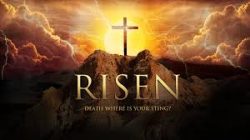 Resurrection, of Jesus is the Christian religious belief that, after being put to death, Jesus rose again from the dead. It is the central tenet of Christian theology and part of the Nicene Creed: “On the third day he rose again in accordance with the Scriptures.” In the New Testament, after the Romans crucified Jesus, he was anointed and buried in a new tomb by Joseph of Arimathea but God raised him from the dead and he appeared to many people over a span of forty days before he ascended into heaven, to sit at the right hand of God. The Resurrection of Jesus is the basis of our hope for our own resurrection.
Resurrection, of Jesus is the Christian religious belief that, after being put to death, Jesus rose again from the dead. It is the central tenet of Christian theology and part of the Nicene Creed: “On the third day he rose again in accordance with the Scriptures.” In the New Testament, after the Romans crucified Jesus, he was anointed and buried in a new tomb by Joseph of Arimathea but God raised him from the dead and he appeared to many people over a span of forty days before he ascended into heaven, to sit at the right hand of God. The Resurrection of Jesus is the basis of our hope for our own resurrection.
Roman Catholic Church – a term which appeared in the English language at the beginning of the 17th century to differentiate members of the Catholic Church (in communion with the Pope) from other Christians who use the term “Catholic”; comparable terms in other languages already existed. Being “catholic” is one of the Four Marks of the Church set out in the Nicene Creed, a statement of belief accepted by many churches even if not in communion with the Pope.
The church known as the “Catholic Church” consists of 24 autonomous churches (all of which are subject to the Pope)— one “Western” and 23 “Eastern” — governed by the same two sets of codes of canon law.
“Roman Catholic” is used by some governments and scholars to refer to members of the majority Latin Church within the Catholic Church. In compound forms such as “Roman Catholic worship” the term is sometimes used to differentiate Western (Latin Church) practices from Eastern.
Roman Curia- C/f Curia above
Roman Martyrology (Latin: Martyrologium Romanum) is the official martyrology of the Catholic Church. Its use is obligatory in matters regarding the Roman Rite liturgy, but dioceses, countries and religious institutes may add to it duly approved appendices. It provides an extensive but not exhaustive list of the saints recognized by the Church.
Roman Missal – c/f Missal, Roman (above)
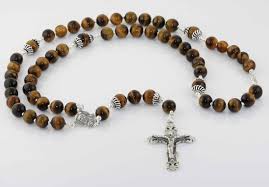 Rosary or Chaplet – (Latin: rosarium, in the sense of “crown of roses” or “garland of roses”), is a form of prayer used especially in the Catholic Church named for the string of prayer beads used to count the component prayers.
Rosary or Chaplet – (Latin: rosarium, in the sense of “crown of roses” or “garland of roses”), is a form of prayer used especially in the Catholic Church named for the string of prayer beads used to count the component prayers.
The prayers that essentially compose the Rosary are arranged in sets of ten Hail Marys with each set preceded by one Lord’s Prayer and followed by one Glory Be. During recitation of each set, known as a decade, thought is given to one of the Mysteries of the Rosary, which recall events in the lives of Jesus and Mary. Normally, five decades are recited in a session. Other prayers are sometimes decade) and before each recitation e.g, the Apostles’ Creed, and after i.e, the Hail, Holy Queen.
A standard fifteen Mysteries of the Rosary, based on the long-standing custom, was established by Pope Pius V in the 16th century, grouping the mysteries in three sets: the Joyful Mysteries, the Sorrowful Mysteries, and the Glorious Mysteries. In 2002 Pope John Paul II suggested a new set of five, called the Luminous Mysteries, bringing the total number of mysteries to twenty.
The 15 decade rosary represents the Church’s emphasis on “participation in the life of Mary, whose focus was Christ”, said to have given to St Dominic by Our Lady in the thirteenth century, The five ‘Luminous’ Mysteries were added by pope St John Paul II
The 20 Mysteries of the Rosary:
The Five Joyful Mysteries
1. The Annunciation (Humility)
2. The Visitation (Charity)
3. The Nativity of Christ (Love of God)
4. The Presentation (Purity)
5. The Finding of the Christ Child in the Temple (Obedience)
The Five Luminous Mysteries
1. Baptism of Jesus (Openness to The Holy Spirit)
2. Wedding at Cana (To Jesus through Marry)
3. Proclaiming The Kingdom of God (Repentance and Trust in God)
4. Transfiguration (Desire for Holiness)
5. Institution of The Eucharist (Adoration)
The Five Sorrowful Mysteries
1. The Agony in the Garden (Repentance)
2. The Scourging at the Pillar (Mortification)
3. The Crowning with Thorns (Humility)
4. The Carrying of the Cross (Patience)
5. The Crucifixion (Love our enemies)
The Five Glorious Mysteries
1. The Resurrection (Faith)
2. The Ascension (Hope)
3. The Descent of the Holy Spirit on the Apostles (Zeal)
4. The Assumption (Happy death)
5. The Coronation of Mary as Queen of Heaven. (Love for Mary)
Sacraments – ceremonies that point to what is sacred, significant and important for Christians. They are special occasions for experiencing God’s saving presence. They are at the same time signs and instruments of God’s grace.
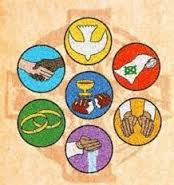
Sacraments, seven – Baptism, Confirmation, Eucharist, Penance, Anointing of the Sick, Holy Orders and Matrimony. They touch all the stages and all the important moments of Christian life. The Church affirms that for believers the sacraments are necessary for salvation”, although not all are necessary for every individual. c/f them the sacraments individually above.
Sacrament of Baptism – c/f Baptism (above)
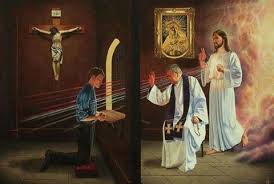 Sacrament of Penance – (commonly called Confession, Reconciliation or Penance) is one of seven sacraments of the Catholic Church and sacred mysteries of Eastern Christianity, in which the faithful obtain divine mercy for the sins committed against God and neighbour and are reconciled with the community of the Church. By this sacrament Christians are freed from sins committed after Baptism. The sacrament of Penance is considered the normal way to be absolved from mortal sins which would otherwise seperate a person fron union with God. As biblical basis for this sacrament, the Catholic Church refers to James 5:16, “confess your sins to one another” and to Jesus’ breathing the Holy Spirit to the Apostles, saying “Whose sins you forgive are forgiven them, and whose sins you retain are retained” (John 20:23).
Sacrament of Penance – (commonly called Confession, Reconciliation or Penance) is one of seven sacraments of the Catholic Church and sacred mysteries of Eastern Christianity, in which the faithful obtain divine mercy for the sins committed against God and neighbour and are reconciled with the community of the Church. By this sacrament Christians are freed from sins committed after Baptism. The sacrament of Penance is considered the normal way to be absolved from mortal sins which would otherwise seperate a person fron union with God. As biblical basis for this sacrament, the Catholic Church refers to James 5:16, “confess your sins to one another” and to Jesus’ breathing the Holy Spirit to the Apostles, saying “Whose sins you forgive are forgiven them, and whose sins you retain are retained” (John 20:23).
Sacrament of
Sacrament of
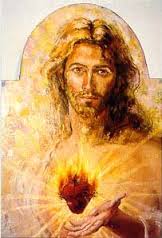 Sacred Heart Devotion – This devotion (also known as the Most Sacred Heart of Jesus, Sacratissimi Cordis Iesu in Latin) is one of the most widely practiced and well-known Roman Catholic devotions, taking Jesus Christ’s physical heart as the representation of His divine love for humanity.It is also popular among some high-church Anglicans and Lutherans.
Sacred Heart Devotion – This devotion (also known as the Most Sacred Heart of Jesus, Sacratissimi Cordis Iesu in Latin) is one of the most widely practiced and well-known Roman Catholic devotions, taking Jesus Christ’s physical heart as the representation of His divine love for humanity.It is also popular among some high-church Anglicans and Lutherans.
The devotion is especially concerned with what the Church deems to be the love and compassion of the heart of Christ towards humanity, and its long suffering. The origin of this devotion in its modern form is derived from a Roman Catholic nun from France, Saint Margaret Mary Alacoque, who said she learned the devotion from Jesus during a series of apparitions to her between 1673 and 1675.
The Sacred Heart is often depicted in Christian art as a flaming heart shining with divine light, pierced by the lance-wound, encircled by the crown of thorns, surmounted by a cross, and bleeding. Sometimes the image is shown shining within the bosom of Christ with his wounded hands pointing at the heart. The wounds and crown of thorns allude to the manner of Jesus’ death, while the fire represents the transformative power of divine love.
Safeguarding – the Irish church child protection policy or the Catholic Church in Ireland: ‘Our Children, Our Church’, is published by the Irish Episcopal Conference, the Conference of Religious of Ireland and the Irish Missionary Union.
It can be viewed online on the Irish Catholic Bishop’s conference website c/f www.safeguarding.ie and all religious orders’ websites or in all public church buildings that include services with/for children. c/f Child Protection Policy (above)
Sede Vacante – a latin expression that refers to the vacancy of the episcopal see of a particular church. It is Latin for “the seat being vacant” (the ablative absolute of sedes vacans “vacant seat”, or the Italian for the same term), the seat in question being the cathedra of the particular church. After the death or resignation of a pope, the Holy See enters a period of sede vacante. In this case the particular church is the Diocese of Rome and the “vacant seat” is the cathedra of Saint John Lateran, the cathedral church of the Bishop of Rome. During this period, the Holy See is administered by a regency of the College of Cardinals.
Shrine – a holy or sacred place of religious devotion, dedicated to a specific deity, ancestor, hero, martyr, saint, or similar figure of awe and respect, at which they are venerated or worshipped. Shrines often contain relics, statues or other such objects associated with the figure being venerated.
Shrines, Irish – Knock, Clonmacnoise, Glendalough, Mellifontabbey, Christchuch, St Patrick’s Cathedral, Monasterboice, Croagh Patrick, Rock of Cashel, Skellg Michael, St Peter’s, Drogheda, Lough Derg.
Shrines, International – International – Divine Mercy Sanctuary, Kraków, Basilica of Saint Anthony of Padua, Sanctuary of Fátima,, Lourdes, Rome, Jerusalem, too many to list here.
 Sin – an offence, wrong-doing, misdeed, any act of violating God’s will or any action that violates the ideal relationship between an individual and God; or an individual and any other person. Ill treating any other creature can also be viewed a sin.
Sin – an offence, wrong-doing, misdeed, any act of violating God’s will or any action that violates the ideal relationship between an individual and God; or an individual and any other person. Ill treating any other creature can also be viewed a sin.
Sin, Original – entered the human world through Adam and Eve’s sin in the Garden of Eden and that human beings have since lived with the consequences of this first sin.
Sin, Mortal – seriously wrong actions, omissions performed with full knowledge and consent that cause one to break one’s relationship with God and lose salvation unless the sinner repents and receives forgiveness.
Sin, Venial – wrong actions against God or other people that rupture our relationship with God and require some sort of penance either on Earth or in the afterlife e.g Purgatory.
Slavery and the Church – The following Popes all condemned slavery. Pope Eugene IV in 1435, Pius II in 1482, Paul III in 1537 He imposed excommunication on those who took part in it), Urban VIII in 1689, Benedict the XIV in 1741 and Gregory XVI in 1838. The Catechism of 1992 continued this long tradition saying the 7th Commandment fibids acts that lead to theesavement f human beings, to their being bought, sold,or exchanged like merchandise, in disregard of their human dignity.
Synod – (pronounced sɪned), comes from the Greek “σύνοδος” (synodos) meaning “assembly” or “meeting”, and it is synonymous with the Latin word “concilium” meaning “council”.a council of a church, usually convened to decide an issue of doctrine, administration or application. Originally, synods were meetings of bishops, In modern usage, the word often refers to the governing body of a particular church or diocese, e.g Limerick Diocesan Synod 2016 involving laity as well as clergy.
Sometimes the phrase “general synod” or “general council” refers to an ecumenical council. The word “synod” also refers to the standing council of high-ranking bishops governing.
 Tabernacle, Old Testament – means “tent,” “place of dwelling” or “sanctuary.” It was a sacred place where God chose to meet His people, according to the Hebrew Bible, was the portable earthly dwelling place for the divine presence, from the time of the Exodus. The image to the left is as Moses designed it – a tent of meeting
Tabernacle, Old Testament – means “tent,” “place of dwelling” or “sanctuary.” It was a sacred place where God chose to meet His people, according to the Hebrew Bible, was the portable earthly dwelling place for the divine presence, from the time of the Exodus. The image to the left is as Moses designed it – a tent of meeting
 Tabernacle, Church – A tabernacle is a fixed locked box in the sanctuary in which the Eucharist is reserved after Mass. When Mass is over the consecrated hosts now the containing the sacramental presence of Jesus are placed in the tabernacle for veneration purposes and for the benefit of the sick.
Tabernacle, Church – A tabernacle is a fixed locked box in the sanctuary in which the Eucharist is reserved after Mass. When Mass is over the consecrated hosts now the containing the sacramental presence of Jesus are placed in the tabernacle for veneration purposes and for the benefit of the sick.
The Trinity icon by Rublev
Trinity, The Holy – The Christian doctrine of the Trinity (from Latin trinitas “triad”, from trinus “threefold”) defines God as three consubstantial persons, expressions, or hypostases: the Father, the Son (Jesus Christ), and the Holy Spirit; “one God in three persons”. The three persons are distinct, yet are one “substance, essence or nature”, co-equal, co-eternal and consubstantial, and “each is God, whole and entire” while distinct from one another in their relations of origin: The Father generates, the Son who is begotten, and the Holy Spirit who proceeds from the Father. Accordingly, the whole work of creation and grace is seen as a single operation common to all three divine persons, in which each shows forth what is proper to him in the Trinity, so that all things are “from the Father”, “through the Son” and “in the Holy Spirit”.
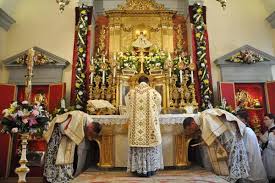 Tridentine Mass Rite – the Roman Rite Mass which appears in typical editions of the Roman Missal published from 1570 to 1962. The most widely used Mass liturgy in the world until the introduction of the Mass of Paul VI in 1969, it is celebrated in Liturgical Latin.
Tridentine Mass Rite – the Roman Rite Mass which appears in typical editions of the Roman Missal published from 1570 to 1962. The most widely used Mass liturgy in the world until the introduction of the Mass of Paul VI in 1969, it is celebrated in Liturgical Latin.
“Tridentine” is derived from the Latin Tridentinus, “related to the city of Tridentum” (modern-day Trent, Italy). In response to a decision of the Council of Trent Pope Pius V promulgated the 1570 Roman Missal, making it mandatory throughout the Western Church, except in places and religious orders with missals from before 1370. Other names used include Traditional Mass and Latin Mass, although the revised form of the Mass that replaced it has its official text in Latin and is sometimes celebrated in that language.
In 2007, Pope Benedict XVI issued the motu proprio Summorum Pontificum, accompanied by a letter to the world’s bishops authorizing use of the Tridentine Mass and Ritual for competent priests. The Pope stated that the 1962 edition of the Roman Missal is to be considered an “extraordinary form” (forma extraordinaria) of the Roman Rite, of which the Missal as revised by Pope Paul VI in 1970 is the ordinary, normal or standard form. Since that is the only authorized extraordinary form, some refer to the 1962 Tridentine Mass as “the extraordinary form” of the Mass The 1962 Tridentine Mass is sometimes referred to as the “usus antiquior” (older use) or “forma antiquior” (older form), to differentiate it from the newer form of the Roman Rite in use since 1970, again in the sense of being the only one of the older forms for which authorization has been granted.
Vacant see — see: Sede vacante (above)
Vatican, the – refers to: The Holy See, the central governing body of the Catholic Church and sovereign entity recognized by international law, consisting of the Pope and the Roman Curia. (c/f Vatican City below, Holy See above)
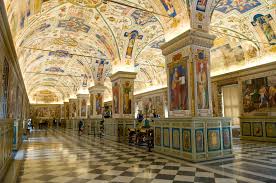 Vatican Apostolic Library – (Latin: Bibliotheca Apostolica Vaticana), is located in Vatican City. Formally established in 1475, although it is much older, it is one of the oldest libraries in the world and contains one of the most significant collections of historical texts. It currently has 75,000 codices from throughout history, as well as 1.1 million printed books. The Vatican Library is also a research library for history, law, philosophy, science and theology. The Vatican Library is open to anyone who can document their qualifications and research needs. Photocopies for private study of pages from books published between 1801 and 1990 can be requested in person or by mail. In March 2014, the Vatican Library began an initial four-year project of digitalising a collection of manuscripts, to be made available online.
Vatican Apostolic Library – (Latin: Bibliotheca Apostolica Vaticana), is located in Vatican City. Formally established in 1475, although it is much older, it is one of the oldest libraries in the world and contains one of the most significant collections of historical texts. It currently has 75,000 codices from throughout history, as well as 1.1 million printed books. The Vatican Library is also a research library for history, law, philosophy, science and theology. The Vatican Library is open to anyone who can document their qualifications and research needs. Photocopies for private study of pages from books published between 1801 and 1990 can be requested in person or by mail. In March 2014, the Vatican Library began an initial four-year project of digitalising a collection of manuscripts, to be made available online.
 Vatican Secret Archives – were separated from the library at the beginning of the 17th century; they contain about 150,000 items.
Vatican Secret Archives – were separated from the library at the beginning of the 17th century; they contain about 150,000 items.
Some believe they house evidence of extraterrestrial life forms, or ancient texts disproving the existence of Jesus or dark truths that would discredit or destroy the church but alas nothing so dramatic.They contain records chronicling intriguing historical local, national and international events.
The ‘secrecy’ is more acurately translated as ‘personal’ or ‘private’ rather than ‘public’ letters. The library has not been secret since 1881 when Pope Leo XIII opened them to scholars of history projects.
Vatican Publishing House, the publisher of official documents of the Holy See, separated from the Vatican Library in 1926.
Vatican City – the city-state ruled by the Pope, in existence since 1929, on the Vatican Hill in Rome, and which includes St. Peter’s Basilica, the Sistine Chapel and the Vatican Museums.
Vatican Hill – One of the hills in Rome, after which the Vatican is named, on the opposite side of the Tiber from the traditional seven hills of Rome.
Vatican Apostolic Palace – the official residence of the Pope on the Vatican Hill (sometimes referred to as the Vatican Palace)
Vatican Basilica – St. Peter’s Basilica, also known as the principal church on the Vatican Hill
Vatican Museums – (Italian: Musei Vaticani) are the museums of the Vatican City and are located within the city’s boundaries. They contain cultural wealth of the Vatican and display works from the immense collection built up by the Popes throughout the centuries including some of the most renowned classical sculptures and most important masterpieces of Renaissance art in the world e.g. The Sistine Chapel with its ceiling decorated by Michelangelo and the Stanze di Raffaello decorated by Raphael are on the visitor route through the 54 galeries of the Vatican Museums. In 2013, they were visited by 6 million people, which combined makes it is one of the largest museums in the world and the 6th most visited art museum in the world.
Vatican watcher – journalists who reports news concerning the Holy See and the Roman Curia
Venerable – In the Latin Church of the Catholic Church, after a deceased Catholic has been declared a Servant of God by a bishop and proposed for beatification by the Pope, such a servant of God may next be declared venerable (“heroic in virtue”) during the investigation and process leading to possible canonization as a saint. Before a person is considered to be venerable, that person must be declared as such by a proclamation, approved by the Pope, of having lived a life that was “heroic in virtue”, the virtues being the theological virtues of faith, hope, and charity and the cardinal virtues of prudence, justice, fortitude, and temperance. The next steps are beatification, from which point the person is referred to as The Blessed, and finally canonization, from which point he is referred to as Saint. For example, Popes Pius XII and John Paul II were both declared venerable by Pope Benedict XVI in December 2009 and John Paul II was declared saint in 2014
Venial Sin – c/f Sin, Venial above
Vestments, Church – liturgical garments and articles associated primarily with the Christian religion, especially among the Eastern Orthodox, Catholics (Latin Church and others), Anglicans, and Lutherans. e.g copes, albs, cotas, humeral veils, stoles, cinctures, amices, chasubles, dalmatics, epicopal gloves, mitres, palliums, zucchettos.
Vicar apostolic c/f: Apostolic vicar (above)
Vicar Forane – A priest appointed by the bishop to supervise a section or district of the diocese
Vicar of Christ – (from Latin Vicarius Christi) is the term used in different ways. As the original notion a vicar is of “earthly representative of God or Christ” but also used in sense of “person acting as parish priest in place of ordinary one.” The title is regularly used to refer to the bishops and more specifically to the Bishop of Rome (the pope. The first record of the concept of the Vicar of Christ is mentioned in the Epistle to the Magnesians of St. Ignatius, Bishop of Antioch, a disciple of John the Apostle, probably commanded by Saint Peter, with a pastoral sense, written between the years 88 and 107 AD “your bishop presides in the place of God (…)”.
Vices – Vice is a practice, behaviour, or habit generally considered immoral, sinful, criminal, rude, taboo, depraved, or degrading. They are pride, greed, lust, envy, gluttony, wrath and sloth. There is a parallel tradition of seven virtues.
Virtues- the seven Christian virtues or heavenly virtues refers to the union of two sets of virtues: the four cardinal virtues, from ancient Greek philosophy, prudence, justice, temperance (restraint), and courage and the three theological virtues, are faith, hope, and charity (or love).
Vow — a solemn promise c/f Simple vow (above) or Solemn vow (above)
Wage, Family — see: Family wage (above)
War, just — see: Just war (above)
Ways, Five — see: Quinque Viæ(above)
Wisdom, gift of – the ability to judge rightly in matters relating to life and conduct; it involves soundness of judgement in the choice of means and ends; thinking and acting using knowledge, experience, understanding, common sense, and insight. Wisdom As a virtue, it is a habit or disposition to perform the action with the highest degree of adequacy under any given circumstance, and to avoid wrongdoing. This implies a possession of knowledge, an understanding of people, objects, events, situations, and the willingness as well as the ability to apply perception, judgement, and action in keeping with the understanding of what is the optimal course of action. It often requires control of one’s emotional reactions (the “passions”) so that the universal principle of reason prevails to determine one’s action. In short, wisdom is a disposition to find the truth coupled with an optimum judgement as to what actions should be taken.
World Meeting of Families 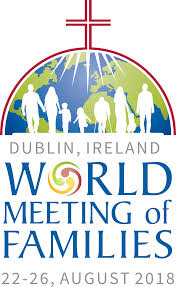 – takes place every three years, and is coordinated by the Vatican’s Dicastery for the Laity, Family and Life. Established by Pope Saint John Paul II in 1992 as a pastoral initiative, its aim is to strengthen the sacred bonds of the family unit across the globe. The first World Meeting of Families took place in Rome in 1994, the International Year of the Family. Every three years since 1994, families from all over the world are invited by the Holy Father to attend this global gathering. During a World Meeting, families come together to share experiences, to dialogue, to pray and work together to grow as individuals and as family units. Delegates participate in discussion groups on the role of the Christian family in the Church and society, and are addressed by distinguished speakers. The eighth and most recent World Meeting took place in Philadelphia in September 2015.
– takes place every three years, and is coordinated by the Vatican’s Dicastery for the Laity, Family and Life. Established by Pope Saint John Paul II in 1992 as a pastoral initiative, its aim is to strengthen the sacred bonds of the family unit across the globe. The first World Meeting of Families took place in Rome in 1994, the International Year of the Family. Every three years since 1994, families from all over the world are invited by the Holy Father to attend this global gathering. During a World Meeting, families come together to share experiences, to dialogue, to pray and work together to grow as individuals and as family units. Delegates participate in discussion groups on the role of the Christian family in the Church and society, and are addressed by distinguished speakers. The eighth and most recent World Meeting took place in Philadelphia in September 2015.
Pope Francis Holy Family prayer for the 9th World Meeting of Families
Jesus, Mary and Joseph, in you we contemplate the splendour of true love; to you we turn with trust.
Holy Family of Nazareth, grant that our families too may be places of communion and prayer, authentic schools of the Gospel and small domestic churches.
Holy Family of Nazareth, may families never again experience violence, rejection and division; may all who have been hurt or scandalized find ready comfort and healing.
Holy Family of Nazareth, make us once more mindful of the sacredness and inviolability of the family, and its beauty in God’s plan.
Jesus, Mary and Joseph, graciously hear our prayer.
Amen.
**************************
Your suggestions for subjects: